Fantasy Books
Book review: Castaways (The Castaways #1) by Craig Schaefer

Book links: Amazon, Goodreads
ABOUT THE AUTHOR:
Publisher: Length: Formats:
Dark academia by Craig Schaefer? Yes, please. Especially the kind that leans hard into the dark. Castaways delivers good story, some eldritch horror vibe, and strong coming-of-age arcs.
Amy Nettle is a classic down-on-her-luck protagonist. She’s stuck in a dead-end life with limited way out. And when things go really south, the mysterious black envelope arrives. Suddenly, she’s whisked away to Saunders Academy, a magical school on a storm-tossed island surrounded by carnivorous mermaids, towering leviathans, and an ever-present sense that something is very wrong.
And if you flunk out? You get sent back to your old life without your magic, your memories, or even the promise of escape. And no one here wants to go back.
I’m a huge fan of Schaefer simple and concise writing. And characters. Amy and her new friends are coming of age in the middle of a mystery that keeps getting bigger and more terrifying. There are hints that this school - and whatever forces control it - are tied to the broader Daniel Faust/Harmony Black universe, and that may suggest an even larger conflict on the horizon.
For fans of Schaefer - it’s not as dark as other series, but it does get dark here and there.
Magic school has never felt this dangerous, and I loved every second of it. Now, where’s the sequel?
We No Longer Need Aliens to Feel Alienated: State of Paradise by Laura Van Den Berg
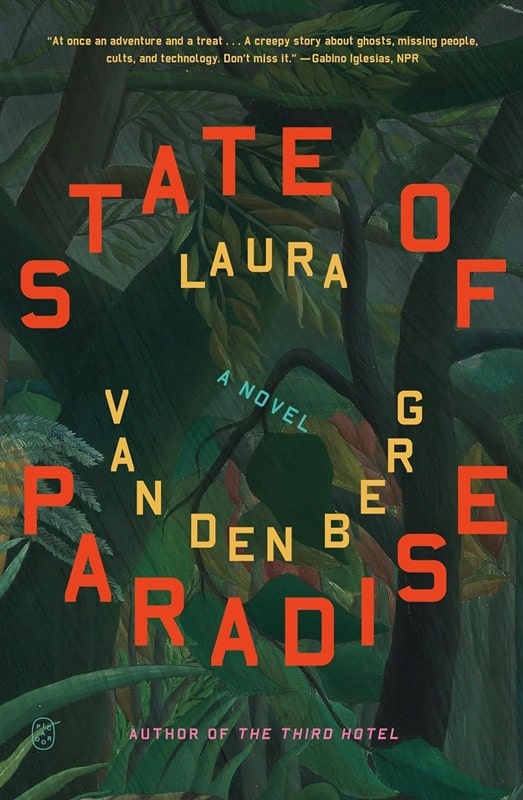
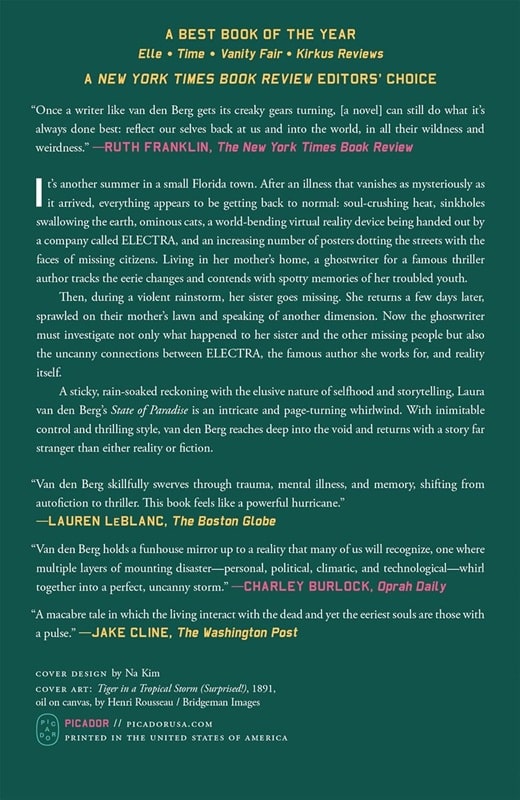
State of Paradise (Picador paperback reprint, July 8, 2025). Cover art:
detail from Tiger in a Tropical Storm by Henri Rousseau, 1891
When I was a kid there was a public service announcement on TV that went something like “Attention: Aliens. You are required by law to report by January 31st.” This was because of the Alien Act of 1940, otherwise known as the Smith Act. Basically, the legislation made it illegal to advocate the violent overthrow of the U.S. government and provided for a tracking system of non-citizens who, in the context of Nazi occupation of Eastern Europe and its then alliance with the Soviet Union, were potential suspects of espionage and sabotage. (Fun fact: prosecutions for advocating overthrow of the government have been ruled as unconstitutional violations of the First Amendment, in case you were wondering how any nitwit on social media can mouth off about doing just that.)
But as I didn’t know anything about this, the announcement always conjured an image of big headed, bug-eyed tentacled Martians registering at the local post office. Which I thought pretty funny. One thing I’ve learned over the years, and particularly these days, is that much of what adults say in all seriousness is often funny, but not in a “ha ha” way. More in a Jean Paul Sartre absurdist kind of way.
Needless to say, alien life forms are foundational science fiction, horror, and fantasy tropes. While some genre writers and filmmakers may very well have thought it just might be cool to tell stories about monsters from other worlds, the notion of aliens amongst us primarily serve as metaphors for, among other things, Communists and related usurpers of “normal” socio-political mores, fears of nuclear holocaust, technology run amok, repressed sexual desire, climate change, disease, and disembodiment.
Probably to a large extent due to the COVID-19 pandemic as well as severe climate events such as the California wildfires, today’s alienation storyline is less “aliens amongst us” and more “us alienated from the world.”
Which brings us to State of Paradise by Laura Van Den Berg.
The title is ironic, referring not only to Florida and its reputation as a refuge for the aged retired, the sunburned, and the weird, but that if the existential human condition is sometimes characterized using the Biblical metaphor of banishment from Eden, we currently find ourselves further away from Paradise than ever before.
In Florida, my husband runs. Ten miles a day seventy miles a week. a physical feat that is astonishing to me. He started running after he got stuck on a book he is trying to write, a historical account of pilgrims in medieval Europe. Back then it was not unusual for pilgrims to traverse hundreds of miles on foot… My husband is a trained historian and fascinated by journeys. He wants to understand what has become the pilgrimages in our broken modern world.
The first person narrator is
…a writer, though not a real one, I ghost for a very famous thriller writer. When I first got the job, I spent a month reading books by the famous author, to better understand the task that lay before me… the phrase everything is not as it seems appeared in nearly all the book descriptions.
Indeed, everything is not as it seems as the narrator (a kind of ghost herself) proceeds on a pilgrimage not only through actually weird Florida, where the 1930s Tarzan movies were filmed and non-native Pythons abound alongside Everglades alligators and Disney characters, but an alternate reality to which her sister and others somehow travel. Along the way are treated to torrential rain and flooding, sinkholes, virtual reality headsets, cults, and cats. And voluntary human extinction meetings. Just another day in Paradise.
With a history of being institutionalized, our narrator may be unreliable, and as a writer she is in the business of making things up. Not much cause for cognitive dissonance given the made-up unreliable narratives of our daily news cycle.
The plot, such that it is, concerns finding out what happened to her sister and others during their disappearances. And along the way what is happening to the narrator as she tries to figure out an increasingly strange world that nonetheless comes to define everyday existence. And whether she can trust what she is experiencing and what she remembers of those experiences.
Sometimes I wonder what we are supposed to do with our memories. Sometimes i wonder what our memories are for. A latch slips and the past floods in, knocking us flat. We leave places and we don’t leave places. Sometimes I imagine different versions of myself in all the different places I have ever lived, inching time in parallel.
This is a novel about the proverbial frog in boiling water, how because as the temperature only gradually rises, we don’t realize we’re being cooked. One absurdity follows another, and it is just how things are. We are now the aliens, journeying towards some unsettling destination, and we don’t have to bother to report.
One of the weirdest things about this period of time is the parts that still seem normal. Mundane and non-apocalyptical. Like how one minute we need an inflatable raft to cross the street and another we’re eating pasta at my sister’s house.
Or as Alice Cooper put it, “Welcome to my nightmare.”
David Soyka is one of the founding bloggers at Black Gate. He’s written over 200 articles for us since 2008. His most recent was a review of Polostan by Neal Stephenson.
Spotlight on “The Mysterious Bakery on Rue de Paris” by Evie Woods
Nestled among the cobblestone streets of Compiègne, there existed a bakery unlike any other. The…
The post Spotlight on “The Mysterious Bakery on Rue de Paris” by Evie Woods appeared first on LitStack.
On McPig's Radar - They Bloom at Night
 They Bloom at Nightby Trang Thanh Tran
They Bloom at Nightby Trang Thanh TranA red algae bloom has taken over Mercy, Louisiana. Ever since a devastating hurricane, mutated wildlife lurks in the water that rises by the day. But Mercy has always been a place where monsters walk in plain sight. Especially at its heart: The Cove, where Noon’s life was upended long before the storm at a party her older boyfriend insisted on.
Now, Noon is stuck navigating the submerged town with her mom, who believes their dead family has reincarnated as sea creatures. Alone with the pain of what happened that night at the cove, Noon buries the truth: she is not the right shape.
When Mercy’s predatory leader demands Noon and her mom capture the creature drowning residents, she reluctantly finds an ally in his deadly hunter of a daughter and friends old and new. As the next storm approaches, Noon must confront the past and decide if it’s time to answer the monster itching at her skin.
Of Men, Monsters, and Little People
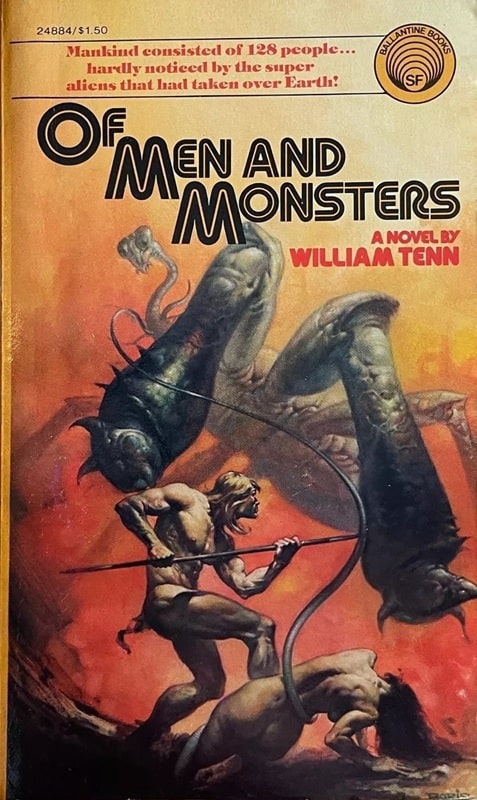
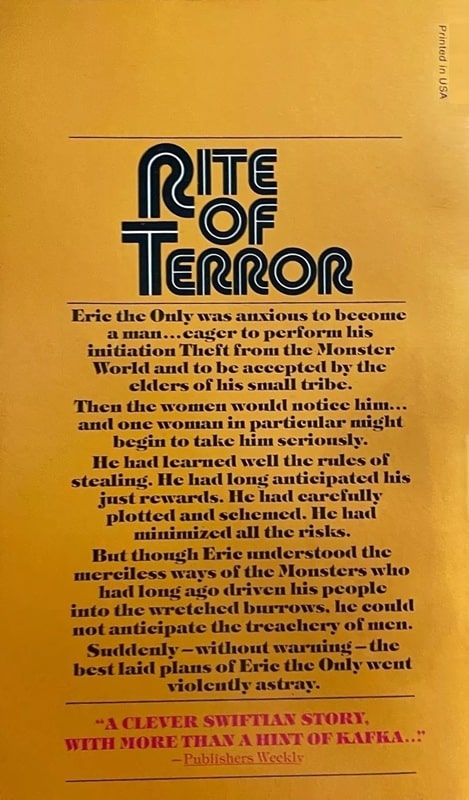
Of Men and Monsters, by William Tenn
(Ballantine Books, December 1975). Cover by Boris Vallejo
After posting about The Borrowers by British author Mary Norton (1903 -1992) last week, several people mentioned other books and movies with similar kinds of themes — little people living in the houses of big people. I thought I might take another post to discuss a few other examples from my own book collection.
First up is series by American author John Peterson (1924 – 2002). The first one was just called The Littles and was published in 1967, 15 years after The Borrowers (1952). The Littles live much like the “borrowers. They look human except for having tails. (In films they apparently look very mouselike but that’s not the case in the books.)
[Click the images for less little versions.]
 The Littles, by John Peterson (Scholastic Books, 1991-1993 editions). Covers by Jacqueline Rogers.
The Littles, by John Peterson (Scholastic Books, 1991-1993 editions). Covers by Jacqueline Rogers.
Unlike with The Borrowers, I never heard of The Littles until I was buying books for my own son, (Josh), even though many were written when I was a kid. I stopped by Josh’s school to pick him up one day and they were having the Scholastic Book fair.
When I was a kid, we never had a fair where you could actually see the books, but we did get the order forms and I bought quite a few books through them for 25 cents or so when in grade school. I had to stop by this one at my son’s school and found out about The Littles. I bought every one they had, ostensibly for my son but at least halfway for myself. I read them all, too, although I don’t think Josh read them all.
There are a bunch of these books and more were written after Peterson’s death, but here are the ones I have. All covers are by Jacqueline Rogers, with charming interior illustrations by Roberta Carter Clark. (These are written specifically for children and I don’t think the stories are as good as in The Borrowers series, but they are fun.)
The Littles, 1967
The Littles have a Wedding, 1971
The Littles and the Trash Tinies, 1977
The Littles Go Exploring, 1978
The Littles and the Lost Children, 1991
The Littles and the Terrible Tiny Kid, 1993
In my twenties I came upon another series about tiny people. This was a trilogy by Gordon Williams (1934 – 2017) that included The Micronauts (1977), The Microcolony (1979), and Revolt of the Micronauts (1981) — all from Bantam Books.
 The Micronauts by Gordon Williams (Bantam Books, August 1977, May 1979, and August 1981). Covers by Boris Vallejo, Lou Feck, and Peter Goodfellow
The Micronauts by Gordon Williams (Bantam Books, August 1977, May 1979, and August 1981). Covers by Boris Vallejo, Lou Feck, and Peter Goodfellow
These are SF novels, not to be confused with the toy series and comic book series from Marvel with the same name — which I’d never heard of until I started looking into stuff for this post. The difference here is normal sized people are cloned at 1/8th their natural size in order to deal with a catastrophic future where most natural resources have been exhausted. The experiment is set up in a controlled environment but things soon get out of control.
I liked all three very much and they had some cool covers. The Micronauts has a Boris Vallejo cover and interior illustrations. The Microcolony has a wonderful Lou Feck cover that I love. Revolt has a Peter Goodfellow cover.
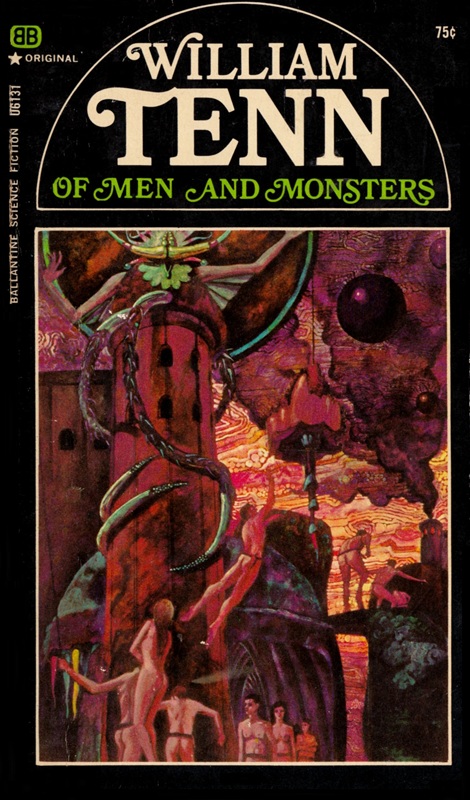
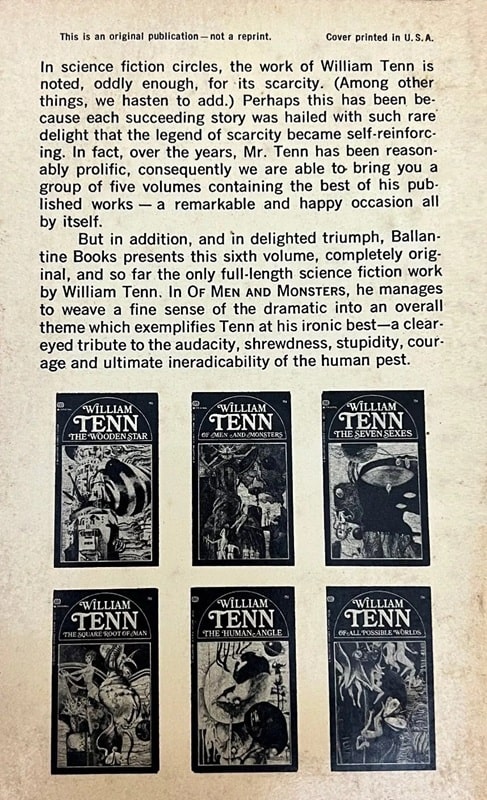
Of Men and Monsters, by William Tenn
(Ballantine Books, June 1968). Cover by Stephen Miller
The last book I’ll review today is one of the first adult SF novels I ever read, Of Men and Monsters, by William Tenn (1920 – 2010). It’s still a fond memory. Tenn was the pseudonym for a British born author named Phillip Klass, although he moved to the US before he was 2. The book was published in 1968 and I read it in a library edition, but years later I bought a Del Rey printing with a great cover by Boris Vallejo (see top).
This one has its own twist on the theme. The people are normal sized, but they are survivors of an invasion by gigantic aliens so huge that the humans can live like mice in their walls. I just loved it, and found out from Adam Tuchman on Facebook that it was originally published in a shorter version in the October 1963 issue of Galaxy, called “The Men in the Walls.”
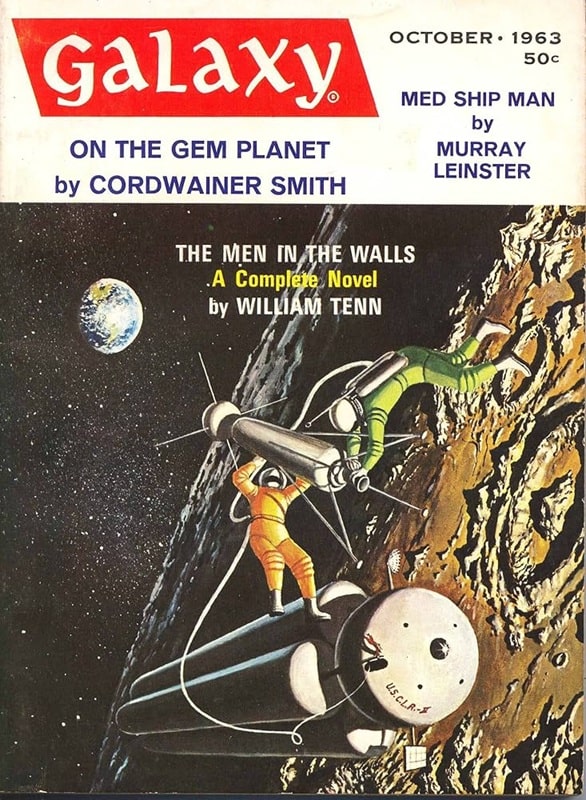
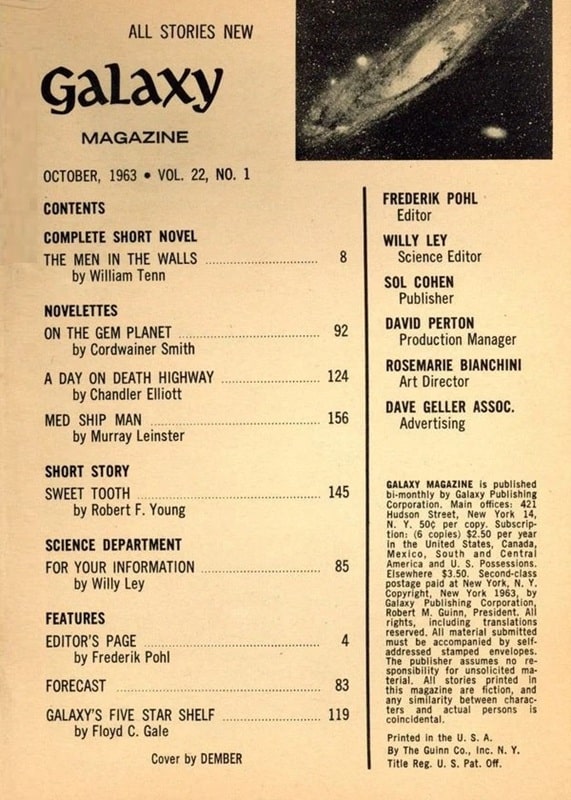
Galaxy, October 1963, containing “The Men in the Walls,” plus stories
by Cordwainer Smith, Murray Leinster, and more. Cover by McKenna
I’ll note that the ending Of Men and Monsters takes us into Sword & Planet territory.
There are plenty more I could talk about here, such as Lindsay Gutteridge’s Cold War in a Country Garden Trilogy, and Ben Sheppard reminded me of an awesome story called “Surface Tension” by James Blish, which deals with the miniaturization theme. There’s Asimov’s Fantastic Voyage, and even the movie Honey, I Shrunk the Kids, but this post is getting long as it is.
Charles Gramlich administers The Swords & Planet League group on Facebook, where this post first appeared. His last article for Black Gate was And Now For Something Completely Different: The Borrowers, by Mary Norton.
7 Author Shoutouts | Authors We Love To Recommend
Here are 7 Author Shoutouts for this week. Find your favorite author or discover an…
The post 7 Author Shoutouts | Authors We Love To Recommend appeared first on LitStack.
The Naturalist Society - Book Review
 The Naturalist Society (The Naturalist Society #1)by Carrie Vaughn
The Naturalist Society (The Naturalist Society #1)by Carrie VaughnWhat is it about:In this magical tale of self-discovery from New York Times bestselling author Carrie Vaughn, a young widow taps into the power that will change the world—if the man’s world she lives in doesn’t destroy her and her newfound friends first.
In the summer of 1880, the death of Beth Stanley’s husband puts her life’s work in jeopardy. The magic of Arcane Taxonomy dictates that every natural thing in the world, from weather to animals, can be labeled, and doing so grants the practitioner some of that subject’s unique power. But only men are permitted to train in this philosophy. Losing her husband means that Beth loses the name they put on her work—and any influence she might have wielded.
Brandon West and Anton Torrance are campaigning for their expedition to the South Pole, a mission that some believe could make a taxonomist all-powerful by tapping into the earth’s magnetic forces. Their late friend Harry Stanley’s knowledge and connections would have been instrumental, but when they attempt to take custody of his work, they find that it was never his at all.
Tied together by this secret and its implications, Beth, Bran, and Anton must find a way for Beth to use her talent for the good of the world, before she’s discovered by those who would lay claim to her rare potential—and her very freedom.
What did I think of it:I got this book as a present from Jeffe, and it's a signed copy as well!I have read books by Vaughn before - Kitty Norville, Martians Abroad - and I really enjoyed those. But I can't say Vaughn was on my watch list. I can tell you that this book changed that!
In this alternate history there's a sort of magic - taxonomy - where if you name something, and know it, you can use the magic/power of that thing or animal. I loved learning more of this magic and how the characters used it in different ways.
As for the characters: I loved Beth from the start. She's smart, knows more about birds than a lot of experts, and managed to teach herself taxonomy, but because she is a woman she is barred from the spaces where she could do something with her knowledge. She managed to get some of her work out there under her husband's name, who (all other stuff he did aside) at least encouraged her work. But when he dies, Beth is back at square one.
Enter Bran and Anton, who were friends with Beth's husband and want to use his work for their own goals.
I really loved Anton as well. He's pragmatic, charismatic, and keeps going to get things done. Bran... still needed to grow up a bit, despite being old enough he should have already. Still I liked him well enough.
I was totally invested in Beth freeing herself from the chains forged by society and find her way. When she befriends Bran and Anton, I rooted for the three of them to realize their dreams. Bran and Anton have a rival, who soon becomes a danger to Beth as well, making me anxious to see them get out of everything alive and successful.
I can safely say I loved everything about this book, even when it made me cry. I can't believe I hadn't seen it mentioned before and only discovered it when I got it as a present. Is it for everyone? I can see how people think it's too dry, there's lots of talk about the science of taxonomy, and there's bits about famous taxonomists at the end of most chapters, but I loved these parts of the book as well (yup: Nerdy Factoids McPig, and proud to be).
You bet I'll be on the lookout for the next book in this world.
Why should you read it:It's a wonderful Alternate History Read.
Book Review: The Buffalo Hunter Hunter by Stephen Graham Jones
I received a review copy from the publisher. This does not affect the contents of my review and all opinions are my own.
 The Buffalo Hunter Hunter by Stephen Graham Jones
The Buffalo Hunter Hunter by Stephen Graham Jones
Mogsy’s Rating: 4.5 of 5 stars
Genre: Horror
Series: Stand Alone
Publisher: Saga Press (March 18, 2025)
Length: 448 pages
Author Information: Website
At its heart, The Buffalo Hunter Hunter may be a vampire novel, but it’s about so much more that calling it such would be doing it a great disservice. Yes, the story involves undead, blood-drinking creatures. However, it is also a meditation on the scars of history, and, like any good western, features a tale of vengeance. In short, Stephen Graham Jones has created something far more complex than your typical vampire horror here.
The novel opens in 2012 with an introduction to Etsy Beaucarne, a junior professor at the University of Wyoming who is desperately looking for a way to revitalize her career. Her opportunity arrives when she comes into possession of a long-lost journal belonging to her great-great-grandfather, a Lutheran priest who lived in the American West in the early 1900s. Within its pages, Arthur Beaucarne had transcribed a stunning confession from a Blackfeet man named Good Stab who claimed to be an immortal vampire.
Through Good Stab’s recorded testimony, readers are plunged even farther back in time to the brutal winter of 1870, when US Army soldiers carried out the Marias Massacre that left hundreds of his people dead. Good Stab, one of the few survivors, swore that he would get his revenge, spending the next few decades hunting down those responsible. Yet his survival came at a heavy price. After losing his family, his home, and even his place in the world, Good Stab’s path changes his life forever. Possessed of both immense power and an insatiable hunger, he knows what happened to him is a curse—but it’s also one he can wield as a weapon against those who destroyed everything he once knew.
From the start, The Buffalo Hunter Hunter’s frame structure brings to mind Dracula, which is not the only nod to the classic. Stephen Graham Jones continues his homage with the epistolary style format, enhancing the story’s eerie, almost folktales-y like atmosphere. Despite its supernatural elements though, some of the most disturbing aspects of the novel are the parts rooted in reality—particularly the history of Indigenous genocide and the annihilation of the buffalo.
In Good Stab’s account, he wasn’t merely seeking revenge for the slaughter of his people, but also for the destruction of his whole way of life. His vampirism not only holds him forever in a state of constant hunger but also traps him in an endless cycle of rage and grief. Immortality offers him no peace but instead forces him to witness more loss as the years stretch on. This makes Good Stab one of the most interesting and tragic characters I’ve ever encountered. He isn’t a hero or a villain—just a man and then a creature driven by circumstance.
Like most vampire stories, The Buffalo Hunter Hunter is unsurprisingly violent and gory. That said, its horror manifests itself in lowkey, slow-burn ways as well. The author’s prose captures the harshness of the frontier, an unforgiving landscape where you are constantly struggling to survive. Though the pacing may be demanding at times, this story simply must be experienced on its own terms, requiring your full attention. With its mix of so many elements from history, mythology, and horror, this is not a book to be rushed but to be absorbed slowly, allowing its haunting themes to fully take hold.
If I had any criticisms at all, it would be that some parts of the story become repetitive at times, especially with regards to the interactions between Arthur and Good Stab. While this back and forth served to reinforce the narrative style, I think the novel could have packed the same emotion punch without being quite so long, and some streamlining would have been beneficial.
In the end, I absolutely loved The Buffalo Hunter Hunter, as in, it just might be my favorite book by the author yet. While it’s not the easiest read, the end results are satisfying and rewarding. Stephen Graham Jones’ storytelling skills are on full display here, and it would make me very happy to see him tackle more historical horror like this sin the future. Granted, I haven’t enjoyed everything he’s written, but when he’s good, he very good. And with this novel, he’s proven once again why he is one of the most important voices in the genre today. If you enjoy horror with depth, especially one exploring a dark chapter of American history, this is a must read.
![]()
![]()
SPFBO Finalist Review: The Tenacious Tale of Tanna the Tendersword by Dewey Conway & Bill Adams

ABOUT THE AUTHORS:
Bill: When not writing, Bill is a product manager for a company that tests food using analytical chemistry and microbiology. Bill currently lives in the greater Chicago, IL area with his wife, goblin (aka toddler) son, & daughter.
Dewey: When Dewey isn’t heads down into drawing or writing, he works as an instructional designer for a major learning management systems company developing online courses. Dewey lives north of Houston, TX with his wife and two dogs while his adult children are off on their own.
Find them online: The Willow Wraiths
The Tenacious Tale of Tanna the Tendersword links: Amazon, Goodreads
ESMAYSometimes you just want to turn off your brain and escape into a wild adventure, and that is exactly when books like The Tenacious Tale of Tanna the Tendersword can come to the rescue. It’s a tongue-in-cheek middle grade fantasy full of action, whimsy and humour that will undoubtedly speak to the hearts of many fantasy lovers, even if it didn’t totally manage to capture mine.
Now, when you have a story with the premise of a 13-year-old grumpy chronicler in training and a hyperactive 12-year-old would-be-champion setting out on a quest guided by a peg-legged, sword-wielding rooster to help save a crying mushroom from an evil sorceress in a haunted forest, you know it’s gonna be a wild ride. And honestly, The Tenacious Tale of Tanna the Tendersword is everything it promises to be, and I found myself effortlessly breezing through the pages.
Despite what the cover and title might make you believe, Tanna is actually not the main protagonist/narrator of this heroic tale (thank all that is holy, girlie and I did not get along), and instead we see it all unfold through the eyes of the grumpy Galdifort. For me, this worked extremely well, especially because I deeply related to his utter exasperation with Tanna’s annoyingly loud, excitable, and slightly brash personality. To me, he almost read a bit neurospicy (though that is never confirmed in the text), and I found it highly amusing to see him desperately trying to stick to the rules while Tanna just ran into chaos every opportunity she got.
That said, I personally felt like there was a lot of missed potential for more nuance, depth, and emotional complexity for these characters, and I soon found myself having a hard time staying engaged in their adventures because I just didn’t care for them. Especially for a story that challenges these young characters in so many unexpected ways, I found the lack of character development to be a bit disappointing.
Don’t get me wrong, not every story needs to be a deep character study or deliver deep philosophical messages, but I think other middle grade stories I have read (like Amari and the Nightbrothers or Nevermoor) just set the bar way higher for me in terms of impact and nuance. Moreover, I felt like this book sometimes had a bit of an identity crisis, with extremely youthful storytelling (I can’t see another CRASH!, BOOM! or ‘fopdoodle’) being mixed with long, convoluted sentences and hectic, violent action sequences that felt confusing regardless of the age of the intended target audience.
Maybe I just wanted this story to be something it was never meant to be, and I have a feeling my little quibbles won’t really bother most other readers. Plus, I think it really shows that the authors had a blast writing this story, and I can’t sit here and pretend that the irresistible chaotic charm of The Tenacious Tale of Tanna the Tendersword didn’t get to me in the end. I absolutely loved the illustrations, the mystery surrounding the disappearance of Galdifort’s aunt and her legendary champion had me eagerly turning the pages, the tongue-in-cheek way that the authors poke fun at the silly conventions of the fantasy genre had me cackling quite a few times, and honestly… how can you not love a peg-legged rooster wielding swords and spitting fire?; Peggs is the true MVP!
And although this adventure wraps up in a satisfying (if slightly rushed) way, the enticing epilogue promises much more danger, mayhem and fun to come for our dynamic duo of unlikely heroes. While I personally didn’t end up loving this story as much as I desperately wanted to, I have a feeling that The Chronicles of Tanna the Champion by Galdifort Quillpen will make fans come back time and time again for more exciting, heartwarming, feel-good adventures to get lost in.
LUKASZ
The Tenacious Tale of Tanna the Tendersword tries to be a quirky, offbeat fantasy romp with an eager heroine, a reluctant sidekick, and a peg-legged rooster who may or may not be hiding a blade. It’s got humor, it’s got adventure, and it’s got an ominous creeping fog. On paper, this sounds like a fun, middle-grade fantasy. In execution? I found it a bit underwhelming.
The biggest issue is that the book doesn’t quite commit to anything fully. The humor is present but not sharp enough to be truly funny. The adventure is in motion but rarely feels urgent or exciting. The magic system has some interesting ideas - time-based gods, song magic - but the story barely scratches the surface. Even the villains, including the ominous Thistle Willow and her foggy menace, feel more like background threats than real forces of tension. Galdifort’s grumpy Chronicler POV is a nice twist, but it doesn’t do enough (deeply subjective) to elevate the story beyond standard fare.
Younger readers new to fantasy might enjoy the lighthearted tone. Since I'm usually looking for something with more depth or originality, this one didn’t leave much of a lasting impression.
OFFICIAL SPFBO RATING

Learning to Live and Love | “Because We Must” a Memoir
Because We Must by Tracy Youngblom is a candid exploration of motherhood and grief Please…
The post Learning to Live and Love | “Because We Must” a Memoir appeared first on LitStack.
Teaser Tuesdays - What Feasts at Night
 Autumn was nearly spent, which means that many of the trees had lost their leaves. you might think that would mean that the woods had opened up, but if you think that, you have likely never been to Gallacia.
Autumn was nearly spent, which means that many of the trees had lost their leaves. you might think that would mean that the woods had opened up, but if you think that, you have likely never been to Gallacia.(page 1, What Feasts at Night by T. Kingfisher)
---------
Teaser Tuesdays is a weekly bookish meme, previously hosted by MizB of Should Be Reading. Anyone can play along! Just do the following: - Grab your current read - Open to a random page - Share two (2) “teaser” sentences from somewhere on that page BE CAREFUL NOT TO INCLUDE SPOILERS! (make sure that what you share doesn’t give too much away! You don’t want to ruin the book for others!) - Share the title & author, too, so that other TT participants can add the book to their TBR Lists if they like your teasers!
SPFBO Finalists Interview - Dewey Conway & Bill Adams, Co-Authors of The Tenacious Tale of Tanna the Tendersword

ABOUT THE AUTHORS:
Bill: When not writing, Bill is a product manager for a company that tests food using analytical chemistry and microbiology. Bill currently lives in the greater Chicago, IL area with his wife, goblin (aka toddler) son, & daughter.
Dewey: When Dewey isn’t heads down into drawing or writing, he works as an instructional designer for a major learning management systems company developing online courses. Dewey lives north of Houston, TX with his wife and two dogs while his adult children are off on their own.
Find them online: The Willow Wraiths
The Tenacious Tale of Tanna the Tendersword links: Amazon, Goodreads
Hello guys, thanks so much for joining us! Would you tell us a little about yourselves, and what made you want to start working together?
Bill: Hallo! Thanks for having us. Not only are we super grateful to even be named a finalist in SPFBOX (and the first ever middle grade book!), we are thankful y’all even want to chat with little ol’ us.
But to answer your question, I’m Bill Adams and I’m a middle grade and adult SFF writer. Aside from The Tenacious Tale, I have an adult dark fantasy series called The Divine Godsqueen Coda that I’ve been working on for mannnny years, and just released the first book, The Godsblood Tragedy, this past summer.
Dewey: Hello, I’m Dewey Conway and I’m a middle grade writer and illustrator. TTToTTT is my first book, but I also illustrate a little on the side and have been starting to branch out into commissioned art.
Bill: It’s an interesting journey we had together. We first started off as critique partners. I sent out the call in 2017 on social media and Dewey was one of the first to answer it. At the time, I was working on a draft of TGT and Dewey was on a first draft of TTToTTT. Not only did we click right away on a writing basis, but on a personal one too. We’ve become very close friends over the years.
Dewey: Arus brought Bill into my life, for sure. We have a dynamic that creatively works really well.
Bill: We really do work together well. I’ll answer it a bit further below, but I truly believed in the story Dewey had started. There was so much there, so many great things about it. I knew that as a middle grade age reader, I would have eaten this story up. I also knew that Dewey was getting a little discouraged by the querying process and seeing as we collaborated really well on altering some of the story over the years, I basically begged him to let me take a crack at an edit of it.
Dewey: I was done. This story and the characters within (especially Galdifort) are shards of my soul, so to have it rejected time after time by agents during querying was discouraging, for sure. I had shelved it for a bit before Bill coaxed me into bringing it back out. We’ll get more into that later.
Bill: It was a journey for sure to get to the self-pub point, but there’s no doubt in my mind, we put out the best story we could, one that would draw in readers not only at middle grade age, but adults too.
Collaborative work is… Well, it’s not for everyone. But you’ve pulled it off. What does it take to successfully co-write a novel? And what was the process for The Tenacious Tale of Tanna the Tendersword ?
Bill: The key for us was trust. Because we started off as critique partners, we learned each other’s styles. Learned how to give feedback. But most importantly, we learned how to bounce ideas off of each other. For me, trusting in that other person implicitly is the biggest way to be a success, because let me tell you, this self-pub industry is not really set up for co-authorship. The systems/processes in place are difficult enough for one author, let alone two.
Dewey: Collaborative work is actually simple. The issue comes with ego. That’s where collaborative work derails. Bill loved this story, loved all the characters, brought to it elements that were missing, and I knew I could trust his intentions. And he knows he can trust me…we’re in this together, baby!
Bill: Ha! Very true, very true. But to bring it back some, early on, the draft Dewey shared with me had spots where I really thought changes could make it even better, one being that Tanna (a girl) was originally Tanner (a boy). After reading the whole draft, I came to Dewey with the idea of swapping gender because we always see boy heroes in stories, and if he wanted to appeal to a larger audience, I felt having a girl be the hero (while keeping Galdifort the grumpy chronicler a boy), the story would really open up for some excellent character dynamics and growth. And Dewey really seemed to agree. This is what I mean by trust. Dewey knew I had the best interest of the story at heart.
Dewey: This was a huge change, and I had to really mull it over, but it just made sense. Tanna was Tanner, but when we shifted him over to Tanna, everything just clicked. The dynamic we needed between Galdifort, who is perpetually grumpy and doubting, with a girl who was genuinely, over-the-top optimistic about everything in life was what the story needed.
Bill: Fast forward to Dewey agreeing to share his creation, we began to outline what we would need to do, not only changes, but how we can successfully launch this story.
Over the years of my writing journey, I really honed my editing skills, so I took our draft and ideas and went to work doing a full-blown edit from the ground up. I aimed to maintain the middle grade voice Dewey is amazing at, plus his penchant for humor and inherent grumpiness in Galdifort, and meld it with a more streamlined story arc, elevating the prose just a smidge so it would also draw in adult readers, while ironing out any kinks.
I’m also a project manager by trade, so I’m very diligent on timelines, on organization, etc. I may dislike it, but I also had been quite active on social media (but really love the indie community there!), so I took on a more ‘business’ role while Dewey remained fully on the ‘creative’ side.
Dewey: This story would not have happened without Bill. 100%. It would be living in my files somewhere under a folder title “Oh Well…”. Bill says he “honed [his] editing skills”...let me clarify. He is THE editor of editors. His eye for story, sense, emotion, and what feels right are beyond scope. BUT the more important part of this is his delivery. He edits with the objective of making the story the best it can be. And, to be honest, I’m a 100% sensitive creative soul, so taking criticism of my work is hard sometimes. I think Bill is one of 3 people that I can take authentic criticism from and listen to that, even if it fundamentally changes the outcome of the work. He is authentic, and this authenticity is a key to our collaborative success.
When Bill finished that final edit sweep, and I re-read it, I went to work on the illustrations and cover. I love drawing, and these characters have always had a certain feel to them that I love to illustrate. Bill had a plan, and we decided to publish on my birthday (April 2) back in January of this year, so I had to get to work on the illustrations, which was a challenge to complete. But nothing has been more satisfying than getting the book out, having it received well, and (most importantly) read by young readers who may now go on to read more fantasy!
Do you have a day job? If so, what is it?
Bill: As mentioned, I’m a project manager, and I work for a company that does food chemistry on food and beverage products. I also had a teaching license in ages past.
Dewey: I am currently an Instructional Designer for a major Learning Management platform, but before this, I taught 5th and 6th grade students for a gazillion years.
Who are some of your favorite writers, and why is their work important to you?
Bill: First and foremost is Richard Adams (no relation sadly) and his seminal work Watership Down. It is the first ‘big’ book I ever read, and he once said something along the lines of ‘a good book is one that is enjoyed when you are six and when you are sixty’ and this really rang home for me as an aspiring writer, especially in the middle grade level. I’m also a huge Terry Brooks fan, as his Shannara books are what got me into fantasy as a teenager in the 90s. Yes, Tolkien is the king, but without Brooks, I don’t think I’d be as big a fantasy fan as I am (I also met him a couple years back and he is one of the nicest people ever!)
Dewey: Well, I have to mention Tolkien. The Hobbit was my first fantasy book I read (I actually played Bill the Troll in a school play haha). This really got me interested in fantasy, but I tend to go for the safe fantasy, the kind that makes me wonder and isn’t necessarily filled with violence and gore. I also love Terry Brooks, but I started with his Kingdom For Sale series as well as the Krondor series by Raymond Feist. I am a huge fan of graphic novels, and Jeff Smith’s Bone is a big influence on me as an artist and author.
What do you like most about the act of writing?
Bill: Writing, and creating fantasy worlds, is my source of joy. I just love the creation part, just that feeling that anything can be done. It’s also an escape from the real world. It’s tough out there, especially now that I’m a parent, so I find solace in these made-up characters/worlds. I also weirdly enjoy the editing phase. I know most people loathe editing and prefer drafting, but I like being able to put meat on the bones and really make scenes pop.
Dewey: I love the creative process as a whole, but sometimes it can be frustrating. It’s a water well that, when it’s full, it’s go go go! I love to sit and just type it all out (more about that below), and the peaceful solitude of writing is so nice. The problem is often finding time for that peaceful solitude.
Can you lead us through your creative process? What works and doesn’t work for you? How long do you need to finish a book?
Bill: Ha, this is where Dewey and I are complete opposites. I’ll let him talk about his process, but let’s just say he’s a planner and I’m a pantster. My outlines are literally a couple of key ideas/concepts/outcomes that take place in each chapter. That’s it. I am a full-on ‘let the characters lead me’ type of writer. I know where things are meant to go, but I have to let my characters do as they will.
Dewey: I do like to plan things out. I like outlines…big chonky outlines with details and asides and rabbit holes into the arcane. I like scribbles on the side of the paper and post-it notes scattered from random thoughts during the day. I want to know the direction my characters are going, every step they’ll take to get there, the motivational arcs outlined, etc. All the stuff. Which, of course, makes this a tedious process.
Bill: When I am in the throes of writing, I can churn out 2k or more words a day and string those back-to-back. If all things are going smooth, I’ve finished 150k drafts of my adult series in a couple of months. However, life isn’t always perfect, so I’d say for me, it would take me about 6 months to have a complete first draft. But again, that’s for my adult books. I think I did the edit of Tanna in little under than 3 weeks, and that’s starting from scratch. It’ll be interesting to dive into book 2 (which we have just started recently) as it will be an all-new ballgame for both of us!
Dewey: Book 2 will be interesting to be sure. I’m super excited about it. I’m not as prolific as Bill, but I get the job done. Eventually.
What made you decide to self-publish The Tenacious Tale of Tanna the Tendersword as opposed to traditional publishing?
Bill: Oh, we tried traditional publishing… To be honest, I still don’t know how we didn’t get a single partial request on this story. It baffles me because we queried for well over a year. Well, let’s be honest, I queried and tried to keep all the rejections away from Dewey’s ears, haha. But I think I queried over 50 agents in that time and I lost count of how many manuscript wishlists had something akin to this story. Truly baffling, but hey, that’s life, right?
But I was in the same boat with my adult series, and one of my other long-time critique partners (also found from that same call out on social media) went the self-pub route, so I had a brain to pick. It just seemed like the right thing to do because I really wanted people to read more stories. So, when Tanna didn’t get a sniff from agents, Dewey and I came to the conclusion we just had to do it ourselves. I think that worked out pretty well?
Dewey: And I’m a control freak. Did Bill say that already? Haha. Bill is so good to me. He did keep the rejections hidden, which is so annoying. But back to control freak, I like to have my hands on every step of the process. Bill and I have a vision in mind, and by golly I’m not going to have someone tell me my illustration doesn’t work, the chapter font is too big, or I need to change a character’s motivation. Nope. If we’re going to do this, we tell and present the story our way.
What’s your favorite and least favorite parts of self-publishing?
Bill: Marketing, plain and simple, is my least favorite. It’s such a creative drain having to feed those algorithms just to hope that someone likes your story enough to read it, maybe give it a review/rating. It destroys my creative well. After releasing Tanna, I had my adult release to look toward, so I didn’t really notice it as much because I was editing, formatting, etc. But post release of my adult in the summer (Tanna was in the spring), I just felt so empty, so devoid of wanting to write. And that was frustrating because writing is my happy place (my favorite part of self-pub because I make the deadlines). I just knew I had to keep going each day with a post or whatever just to remain relevant when all I wanted to do was crawl into the fetal position and burrow my way out of post release blues and write.
Dewey: My favorite part of all this is when we get a review that someone’s child loved it! That makes this grumpy little heart just happy as a clam. My least favorite has to be all the technical aspects of publishing. I realize it has become simpler, but there’s a lot to it.
Why did you enter SPFBO?
Bill: I’ve been following SPFBO for about 5 years or so when I read Senlin Ascends. I had learned it was originally self-pubbed and part of this comp. When the decision was made in 2020-21 to go the self-pub route, I decided to really dive into indie books, and now, I almost exclusively read self-pubbed books. And I used this comp as a source to find good indie reads. Dewey can add something if he likes, but I was the driver of entering as he wasn’t familiar with it at the time. I knew having a middle grade book in the comp, where middle grade and YA to an extent are usually overlooked, would help get eyes on our story. I figured why the heck not.
Dewey: Bill has his finger on the pulse of the indie community. I’m not very active with social media, and he has really developed a considerable amount of respect amongst our peers. He knew about this contest, told me he was entering us, and that was it. It was only when we hit the semi-finalist stage that I perked up about it, because, to be honest, I just didn’t know how special this contest was. And it’s hard when you’ve been rejected so many times by traditional agents to have positive thoughts, so I really didn’t think we would go anywhere until I listened to our semi-finalist judge, Brian Bell, talk about Tanna and all the nice things he said about reading it. It made me pause and listen to Bill, who never stopped believing. I am just beyond grateful to think our peers find our little tale a good read.
How would you describe the plot of The Tenacious Tale of Tanna the Tendersword if you had to do so in just one or two sentences?
Dewey: In The Tenacious Tale of Tanna the Tendersword, would-be Champion Tanna teams up with her reluctant Chronicler-in-training, Galdifort Quillpen, to secure her first quest in an offbeat, pig-filled town. When an eerie fog and rumors of a dark sorceress threaten the townsfolk, the two—guided by a peg-leg rooster—must embark upon an adventure to gain a first quest and uncover the true dangers awaiting them in a shadowy, haunted forest.
What was your initial inspiration for The Tenacious Tale of Tanna the Tendersword? How long have you been working on it? Has it evolved from its original idea?
Dewey: I was initially inspired to make the story a graphic novel, way back in the late 90s. It was a tale of 3 monks who were setting out to find the perfect quill. The monks were named Tanner, Galdifort, and Lasser. Over time, that all changed until I created a comic called Monks back in the 2000s, where Tanner was the last of his kind, being pursued by an evil sorcerer’s enclave for the demon he unwittingly was holding at bay. This is the comic that introduced Cobbs and Wink, characters both still in the story. When I began teaching 5th grade students, I was inspired by that age group and the innocence of the stories they read, so I shifted and tried my hand at writing middle grade. From there, it became the backbone of what it is now.
What genre does it belong to?
Dewey: This is middle grade fantasy fiction.
If you had to describe it in 3 adjectives, which would you choose?
Dewey: Heroic
Bill: Heartfelt
Dewey: Humorous
Is it part of the series or a standalone? If series, how many books have you planned for it?
Bill: It is the first of a proposed trilogy. Without spoiling much, a Champion (what Tanna is inspired to become) has an item called an Elemstone, which gives a Champion extra powers so to speak. And as the would-be-Champion progresses, they get a piece of the Elemstone, or triad. Kinda like the TriForce in Legend of Zelda. So, three books, three pieces of Elemstone.
Who are the key players in this story? Could you introduce us to The Tenacious Tale of Tanna the Tendersword’s protagonists/antagonists?
Dewey: Let’s see…
Protagonists:
● Tanna the Tendersword: a bold, optimistic would-be-Champion determined to prove herself by finding her first quest
● Galdifort Quillpen: Tanna’s Chronicler-in-training, he’s pragmatic and grumpy who very reluctantly goes along with Tanna, he’s also our POV
● Peggs the Rooster: a mysterious, peg-legged rooster who acts as an unconventional guide, who may hold a secret himself
Antagonists:
● What’s-Her-Name (Thistle Willow): A mysterious and feared sorceress whose presence brings darkness and the ominous Fog Blight
● The Fog Blight: A supernatural, creeping fog rumored to put people under her control or lure them to their doom
● Fechus, Scratch, and Mulch: A trio of mischievous creatures known as Throgs who appear in the fog, in league with Thistle Willow
Does your book feature a magic/magic system? If yes, can you describe it?
Dewey: Yes, the magic system in this story is based on time. The gods presented are the Three Scribes, who represent past, present, and future. They are said to provide the Champions of the land of Handover (that’s the name of the kingdom) with magical might, empowered through the Elemstones (Bill mentioned that earlier). There’s also an antithesis magic, represented by our antagonist, Thistle Willow. Our next two books will dive into this a little more.
Bill: You’re forgetting song magic, Dewey! Both Thistle Willow and a secondary character named Byrna (Galdifort’s friend and crush) use songs to manipulate the things around them. We plan to explore further with this in the other two books like Dewey mentioned above.
Have you written the book with a particular audience in mind?
Bill: Kids, 100%. Brian Bell (our sub-judge on Team Chase) made a great point, this book is a wonderful gateway for kids to get into fantasy as they grow. That’s exactly what we set out to do! But let’s not forget, this book has a lot for adults to love too. So we like to say it’s for all ages.
What’s new or unique about your book that we don’t see much in speculative fiction these days?
Bill: As I mentioned above, making Tanna (a girl) be the hero and Galdifort (a boy) be the more cautious, bookish type is something you don’t see all that often. We also wanted to show healthy admiration for people not the same as them. Galdifort’s aunt is his idol and she’s the most famous Chronicler in his world. And Tanna wants to be like Cobbs, the famous Champion Galdifort’s aunt chronicled for. We thought it very important for kids to see that you can root for and want to be like people who aren’t like you or don’t look like you.
Dewey: In addition to what Bill said, I think what’s unique or might surprise the reader is that the story is told from Galdifort’s point of view, even though the title is The Tenacious Tale of Tanna the Tendersword. Tanna is a player in Galdifort’s story as a Chronicler. His grumpy perspective is something I think most would not expect.
Bill: I mean, we also have a peg-legged rooster companion that may or may not have a sword within said peg-leg…

Cover art is always an important factor in book sales. Can you tell us about the idea behind the cover of The Tenacious Tale of Tanna the Tendersword and the artist?
Dewey: I did the cover art, and the design came while I was eating dinner one night. I suddenly saw Tanna leaping into action, head on, ready to face whatever perils await her while Galdifort stood behind her, an expression of complete doubt and subtle fear. That image stuck with me and so I sketched it out, placed them square in the Dwimmerleaf Forest (where Thistle Willow dwells), and added Peggs. I wanted them to be front and center for the story, so a prospective reader knew from the start that this tale was all about adventure with a plucky hero. The idea to add the silhouette of Thistle Willow behind them came a little later when I realized I needed to also convey danger. For the lettering of the title, I drew a font that I imagined Galdifort would draw (he is a Chronicler after all) and placed it on a leathery, silver lined plaque.
I think it catches the eye, for sure, but I wanted it to tell the reader what they were in for: a fun adventure with unconventional characters.
What are you currently working on that readers might be interested in learning more about, and when can we expect to see it released?
Bill: I’m currently putting the final touches on book two of The Divine Godsqueen Coda, hoping to reveal the cover in the next month or so, and release around February. I’m also working on a Sci-fi novella that I want to release in December. My guy Dewey is working on my cover as we speak! Then comes my part on Tanna 2!
Dewey: I’ve been doing some illustrations for indie authors lately, but I’m currently working on Bill’s cover for his novella. Tanna part 2 is also on the horizon!
Thank you for taking the time to answer all the questions. In closing, do you have any parting thoughts or comments you would like to share with our readers?
Bill: First off, again, thank you for having us, this has been great! Second, thank you to team Fantasy Book Critic for being judges and championing indie authors! But yeah, I suppose I just want to say to everyone reading this interview, please go out and support the rest of these finalists, all the semi-finalists, all the 300 authors who submitted and made the comp (as well as the almost 300 who didn’t in the lottery), as well as any indie author. I know TBR lists are unfinishable, but support and hype goes a long way for us little authors. Thank you!
Dewey: Yes, thank you! I am excited, thrilled, nervous, and humbled by everything that’s happened. There are so many incredible authors with amazing stories and to even be mentioned in the same breath as them is just unbelievable. I’ve learned the indie community is one of the most welcoming and hard-working group of creatives, so please support them. Again, thank you for reading our interview and being a champion. Smack gobble!
Taking the Ridiculous Seriously
 Look! It’s fun! Image by Patrycja Kwiatkowska from Pixabay
Look! It’s fun! Image by Patrycja Kwiatkowska from Pixabay
Good afterevenmorn!
I hope everyone who has to suffer through the daylight savings shift Sunday are coping with losing that hour of sleep. To those to whom that does not apply, know that I am fiercely jealous of you. But let’s not dwell on our minor hardships. Today, I want to talk about writing, and very specifically how to make situations that are absolutely ridiculous on the outside feel real and very serious.
This came to me as I walked home from work today, thinking of my serialised novel (online on my blog every Friday until it concludes… look at me dropping a plug). It has, if you were to distill it down, the silliest, most ridiculous premise you could possibly imagine: Zombies, but make them hyper-aggressive, human-sized fairies.
Yup.
It’s so dumb. On the outside of it. And to be fair, I had so much fun writing it; giggling like a twit at how silly it all actually is. I take great delight in pointing out the hilariously ridiculousness of the premise. If I managed to do it well, then it will feel a good deal more serious than it seems when you distill it. If I pulled it off, it won’t feel how ridiculous it is. Whether I did or not is not really for me to decide, but here are some things I did in an effort to make it work. Maybe they’re something you can think about if you find yourself in a similar situation.
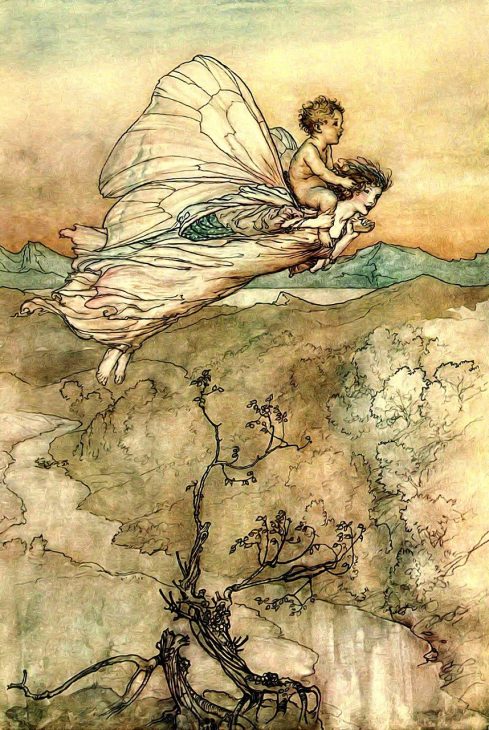 Image by Prawny from Pixabay
Image by Prawny from Pixabay
1. The situation might be ridiculous, but your characters don’t know that.
Let’s be honest. If you’re fighting for your life in a city that has been overtaken by a swarm of mindless winged humanoid killers, you’re probably going to be too busy trying to survive to worry about how silly it all actually is. That might come later, after you have done the surviving. If your characters treat their situation seriously (and it kinda is; they’re fighting for their lives), it’ll be much easier for your readers to suspend their disbelief while reading it. They’ll buy human-sized fairies attacking in swarms and consuming a city of millions in less than twenty-four hours.
It will probably also help to have at least one character who is familiar with really weird situations. Think of Mulder and Scully in the X-Files. They’re constantly facing things that, on the outside, are completely unbelievable, even ridiculous. But it works precisely because they take it seriously when they’re in the moment, and Mulder is a believer. However weird or out there a situation is, Mulder just accepts is as fact and rolls with it. It makes it easy for the viewer to do the same.
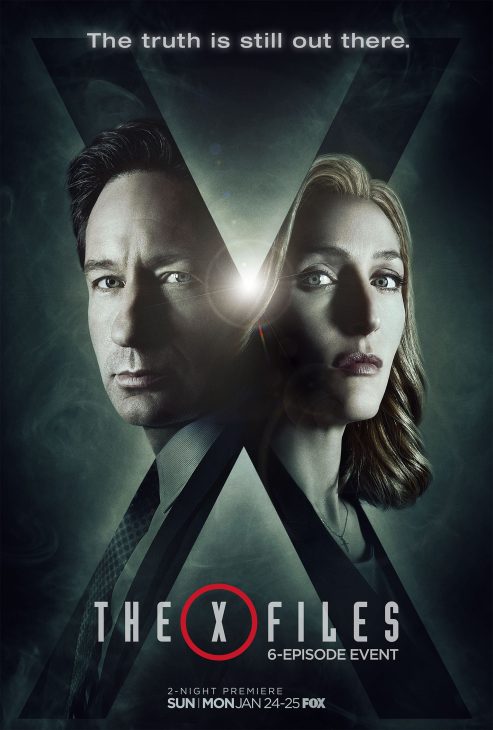
2. The situation is ridiculous, and your characters absolutely know it.
This isn’t an and/or situation with number one, trust me. If I found myself facing a mindless winged humanoid, I would absolutely demand of no one in particular what the actual f[redacted]. Having a character call out the idiocy of the situation they find themselves in — while taking it very seriously — is may be a way to get readers on board. This is especially true if the world you’ve built is encountering the situation for the first time.
If winged humanoids are a normal thing in the world, then having a character acknowledge how stupid that seems, will probably distance the reader and make it hard for them to suspend their own disbelief. However, if these creatures are not a part of your characters’ every day reality then having someone be absolutely incredulous at the situation they face will help your reader relate, making it easier for them to sink into the story.
It works for me, in any case. If the characters I’m reading aren’t absolute morons that question absolutely nothing, then I’m much more amenable to accept the scenarios they’re put through. Mind you, I’m not an especially critical reader, so I get sucked into stories a lot more frequently than most. It is both a blessing and a curse.
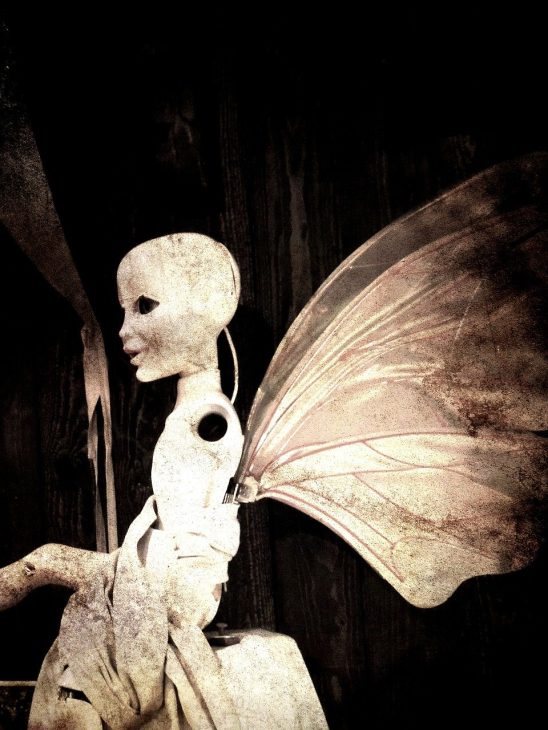 Image by Karen Nadine from Pixabay
Image by Karen Nadine from Pixabay
3. Keep it grounded
This might sound impossible, given the fantastic situation you’re trying to create, but keeping it as grounded as possible will help. There are a number of ways to do this. Providing real consequences for mistakes is one. Have people get hurt, or die. People will suffer in these situations if they ever actually happened; there will be grief, and fear, and anger. You’re already stretching incredulity with the situation. Have everyone dancing along unscathed will be pushing it much too far. This is especially important if it’s not taking place in a world that is easily relatable. I got a leg up, because the serial is set in a fictional city, but in the real world and set in 2024. There are a lot of touchstones that are easily digested for a reader.
It becomes harder if the entire world is fantastical. Finding something grounding in a world where trees talk or teleport, or whatever, is much harder. It’s not impossible, though. Find those touchstones and use them.
Did I achieve creating a story that brings people along and has them absolutely invested while also having gate silliest premise I think I could possibly conjure? No idea. But I tried, and I used these three (and other) things in the attempt. Maybe they’ll help you, too. If you’ve read books or are currently writing one which has an absolutely ridiculous premise, let me know what, and what worked (or didn’t). If you have any tips of your own for making a silly premise both believable and feel serious, also let me know in the comments below.
When S.M. Carrière isn’t brutally killing your favorite characters, she spends her time teaching martial arts, live streaming video games, and cuddling her cat. In other words, she spends her time teaching others to kill, streaming her digital kills, and a cuddling furry murderer. Her most recent titles include Daughters of Britain, Skylark and Human. Her serial The New Haven Incident is free and goes up every Friday on her blog.
Book Review: Rose of Jericho by Alex Grecian
I received a review copy from the publisher. This does not affect the contents of my review and all opinions are my own.
 Rose of Jericho by Alex Grecian
Rose of Jericho by Alex Grecian
Mogsy’s Rating: 4 of 5 stars
Genre: Horror
Series: Stand Alone
Publisher: Nightfire (March 11, 2025)
Length: 352 pages
Author Information: Website
Rose of Jericho by Alex Grecian returns to the dark and supernatural world first introduced in Red Rabbit, his 1880s western horror novel. While this is technically a follow-up that revisits the witchy trio of Sadie Grace, Rabbit, and Rose, it still stands solidly on its own, allowing new readers to jump in without needing prior knowledge. And personally, I found this new book to be even stronger and more immersive than its predecessor.
The book begins with a tragedy. A man named Moses Burke loses both his beloved wife and newborn child, and in his grief, takes on Death himself and murders him. Readers are transported back to the remote village of Ascension, Massachusetts, where the result of Death’s absence is subsequently illustrated in a bizarre string of events that go against the natural order. A gruesome accident that should have killed a boy instead leaves him walking around with a hole in his chest. Likewise, a terminally ill woman finds that the progression of her disease has halted, so she can suddenly get out of bed and go about her day. A hanged man calls out while still hanging from the noose, even with his neck broken and eyes pecked out by crows. And on and on it goes. It appears people can no longer die! While this revelation is met with confusion, there is also no small amount of excitement.
However, the longer this reality persists, the more the town and its residents are feeling its dark effects. Inside, those who should have been dead are changing, becoming more dangerous. Newly arrived in town, Rabbit, Sadie Grace, and Rose watch as chaos descends upon Ascension. As the three women attempt to find out what’s going on, they must also contend with the restless entities that haunt Bethany Hall, the old house they are staying in while they help take care of Rose’s sick cousin.
Unsurprisingly, Rose of Jericho delves into some thought-provoking themes, questioning the significance of mortality by exploring the balance between life and death. The Grim Reaper is literally killed off in a fit of rage, and the ripples created by this one impulsive act result in grave consequences for everyone on the planet. For the deeply religious townsfolk of Ascension, you can just imagine their struggle to reconcile their beliefs with what’s happening around them, and though readers only get to see the effects on this one little slice of the world, we can easily surmise that all hell has broken loose across the globe as well.
Speaking of Ascension, the author also does a fantastic job of bringing the town to life, making it feel even more vivid and immersive than I remember from Red Rabbit. This sort-of sequel gave us a chance to see more of the town, providing a deeper look into its people, customs, and day-to-day struggles—though admittedly, describing their “daily life” takes on a more sinister meaning when we’re talking about a world where no on can truly die. As the characters go on existing in this strange limbo, we watch some of them embrace what they believe is a gift or miracle, while others who are more skeptical end up succumbing to fear and paranoia.
All in all, Rose of Jericho is a unique dark fantasy novel that balances horror and grim humor while providing plenty of food for thought. The overall vibe is a mixture of eerie gothic and surreal western, presenting a weird but refreshing premise that keeps the story engaging and unpredictable. I found Alex Grecian’s prose and character work to be much stronger here than in Red Rabbit, but whether you’re returning to this world or a complete newcomer, I believe Rose of Jericho is an interesting and strange journey worth taking.
![]()
![]()
Spotlight on “Big Chief” by Jon Hickey
Big Chief, Jon Hickey’s gripping literary debut about power and corruption, family, and facing the…
The post Spotlight on “Big Chief” by Jon Hickey appeared first on LitStack.
Eleven Years of Monday Mornings with Bob
Wow. Eleven years ago today, on March 10, 2014, I became an official Black Gate blogger. The Public Life of Sherlock Holmes kicked off a three year run, bringing a mystery presence every Monday morning. I roamed off topic a bit – but NOTHING like I do now. I mean, did you read last week’s baseball post?
Encouraged by my buddy William Patrick Maynard (an established Black Gater), I went from some uknown guy commenting on other people’s posts, to a moderately interesting weekly columnist. And every World Fantasy Award-winning website, with an amazing roster of bloggers, needs a mystery column, right???
I talked about joining Black Gate in my chronicle of what passes for my writing career: Ya Gotta Ask.
And So It Began
By my count, I have written 510 posts here at Black Gate. That doesn’t include those posts I’ve hoodwinked folks…I mean, ones written by my gracious and talented friends. Discovering Robert E. Howard, Hither Came Conan, Talking Tolkien, and A (Black) Gat in the Hand have included some FANTASTIC stuff from others, and I’m very grateful to everyone who has used my Monday morning slot to make Black Gate even better.
I average about 1,000 words a post, and I frequently go over; I don’t go much under that (I write like I talk…). So, It’s not unreasonable to say I’ve written a half a million words here at Black Gate, over the past eleven years.
It’s been a fantastic ride, and I’ve gotten to write extensively about Sherlock Holmes, Robert E. Howard, Nero Wolfe, John D. MacDonald, Douglas Adams, Humphrey Bogart, RPGs and gaming, TV shows and movies, hardboiled Pulp, and pretty much anything else I like. I’m very ‘Squirrel!’.
I’ve created some regular features, such as What I’ve Been Watching, What I’ve Been Reading, and What I’ve Been Listening To (audiobooks).
Hither Come Came Conan will always be one of the proudest achievements of my writing career. And I honestly think if I could find out how, A (Black) Gat in the Hand should win some kind of mystery award.
I’ve tried to add new multi-contributor series’. I haven’t managed to pull one off for Solomon Kane, or John D. MacDonald, or Columbo, or Star Trek. But I haven’t necessarily given up yet. And I’m sure more will come to mind.
I have grown as a writer in many ways, in my eleven years at Black Gate. I know I’m a better blogger than when I started. Not that that would have been hard to do…
I did a 24? in 42 podcast interview with Rogue Blades’ Jason Waltz, which just dropped last week. It’s the topic of next week’s post.
When he threw me a curveball with the first question (‘What color do you write in?’), I ended up talking about engagement. I write about things I’m interested in. I rarely write negative columns. I don’t wanna spend a thousand words bitching about something I don’t like (I’ve got Facebook and Reddit for that). I will be critical, sure. But if I hate the latest ‘whatever it is,’ I’m gonna find something else to write about.
I wanna share things I’m interested in. I know some folks have gone on to check out topics I’ve talked about. My annual summer Pulp series has been good for that. And I like when people comment. It means I made some kind of connection. I try to reply to every comment, and I think I’m about 98%. Engagement.
I hope when somebody reads my Monday morning post, they enjoyed it. But more, I hope it resonated somehow. I’ve learned things, and gotten recommendations, from the comments. Engagement.
BG head honcho John O’Neil praised my stuff by saying I try to educate people. That’s part of me sharing stuff I enjoy. If there was a Norbert Davis Appreciation Society, I would be the president. So, I’ve written about the under-appreciated Black Mask Boy, several times. I’ve written a lot about Nero Wolfe, John D. MacDonald, and Terry Pratchett. They are three of my favorite writers, and I want to share with readers here. It’s obvious I’m a huge Douglas Adams fan, if you do a search on the site.
And I’ve certainly espoused my love of Robert E. Howard here at Black Gate.
I joke that I’ll keep doing a weekly column for as long as I can get around the firewall.
My life has changed a lot since I started this column. Divorce, moved, changed jobs (there was some kind of Pandemic, I hear…). But I have averaged 46 essays a year, for 11 years. And it would be many more, if I didn’t conned folks into writing some for me, once in awhile.
I talk about other Black Gaters who are Writers with a capital ‘W.’ And I consider myself a lower case ‘w’ writer.
But you know what? I’ve won three awards for my writing (and editing). You can buy my short stories in anthologies on Amazon. I was a regular columnist for a British mystery magazine. And I’m writing intros to books published by Steeger Books – sometimes with a cover mention. I followed Ian Esslemont (I’m a Malazan fan) on a podcast for authors. Ian Esslemont!
And I’ve been doing a thousand words a week, for eleven years. In this age, being a blogger is a valid way to write. I’m finally gonna give myself that capital W.
So, until they tighten up the firewall, I plan on continuing here at Black Gate for a while. Hope you keep finding things you like to read. And leave some comments. Let’s have a discussion.
Let’s engage.
And today’s post title is a nod to a popular memoir by sportswriter Mitch Albom, Tuesdays with Morrie.

Bob Byrne’s ‘A (Black) Gat in the Hand’ made its Black Gate debut in 2018 and has returned every summer since.
His ‘The Public Life of Sherlock Holmes’ column ran every Monday morning at Black Gate from March, 2014 through March, 2017. And he irregularly posts on Rex Stout’s gargantuan detective in ‘Nero Wolfe’s Brownstone.’ He is a member of the Praed Street Irregulars, founded www.SolarPons.com (the only website dedicated to the ‘Sherlock Holmes of Praed Street’).
He organized Black Gate’s award-nominated ‘Discovering Robert E. Howard’ series, as well as the award-winning ‘Hither Came Conan’ series. Which is now part of THE Definitive guide to Conan. He also organized 2023’s ‘Talking Tolkien.’
He has contributed stories to The MX Book of New Sherlock Holmes Stories — Parts III, IV, V, VI, XXI, and XXXIII.
He has written introductions for Steeger Books, and appeared in several magazines, including Black Mask, Sherlock Holmes Mystery Magazine, The Strand Magazine, and Sherlock Magazine.
Book review: Once Was Willem by M.R. carey

ABOUT THE AUTHOR: Mike Carey is the acclaimed writer of Lucifer and Hellblazer (now filmed as Constantine). He has recently completed a comics adaptation of Neil Gaiman's Neverwhere, and is the current writer on Marvel's X-Men and Ultimate Fantastic Four. He has also written the screenplay for a movie, Frost Flowers, which is soon to be produced by Hadaly Films and Bluestar Pictures.
Also writes as Mike Carey
Publisher: Orbit (March 4, 2025) Length: 310 pages Formats: audiobook, ebook, paperback
Finally, something fresh. Once Was Willem is part medieval horror, part dark fairy tale, part found-family adventure.
Our narrator, Willem, was once a regular 12-year-old boy. Then he died. His grieving parents let a sorcerer bring their dead son back to life. Since Willem has been in the ground for a while, what rises from the grave is… not ideal. He’s stronger, uglier, and-despite still having his memories-not exactly welcome back at the dinner table. His parents panic, the village does what angry mobs do best, and Willem, now Once-Was-Willem, finds himself on the run.
Banished from the only home he’s ever known, Willem finds a new life in the deep woods, where he befriends a group of monsters who, like him, have been cast out. Meanwhile, the sorcerer, Cain Caradoc, is busy setting up shop in a fortress built on the bones of a sleeping angel and preparing a mass sacrifice of children to fuel his quest for godhood. Eventually, the terrified villagers realize that only “monsters” they ran off can save them. Oops.
This book is dark, and it has some truly stomach-churning moments, but it never feels dreary. It’s sharp, self-aware, and laced with a dry, biting humor that makes even the bleakest parts go down easy. Willem himself is an excellent protagonist/narrator: a lonely, tragic figure with a surprising amount of warmth. You want him to find belonging. You want him to win. And when the time comes to face Caradoc, you really want him to rip that smug sorcerer apart.
If you like your fantasy a little twisted, your heroes a little ugly, and your villains really vile, Once Was Willem is absolutely worth your time.
One of the Finest Achievements of Heroic Fantasy in the 20th Century: Dilvish, the Damned by Roger Zelazny
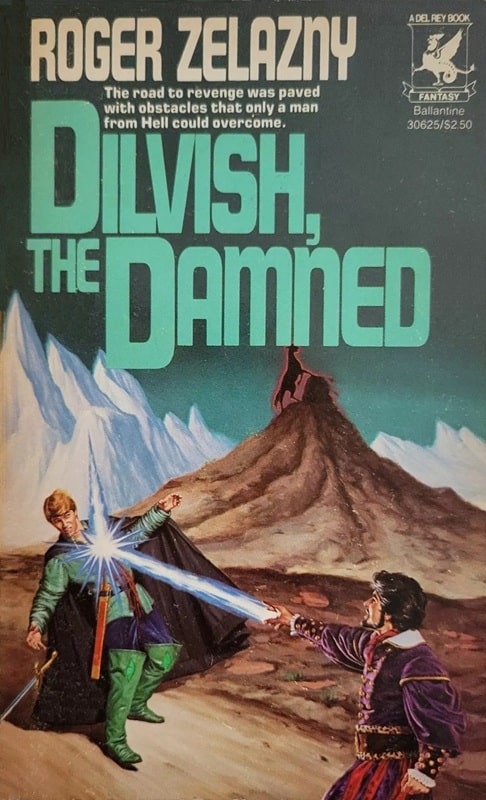
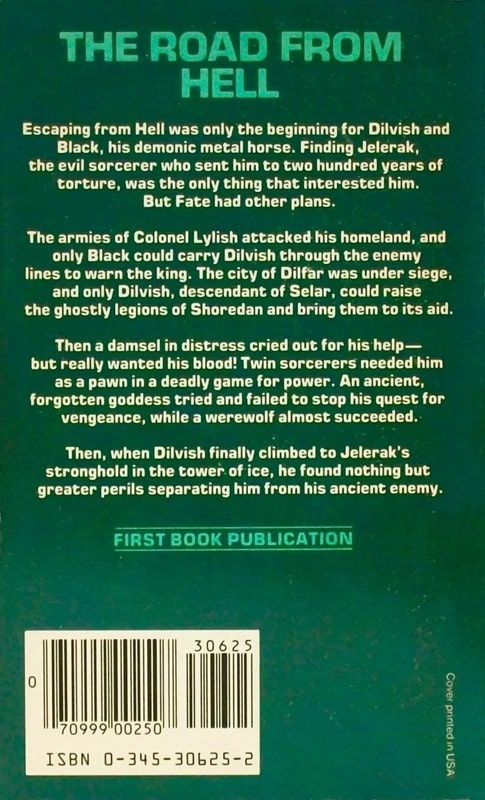
Dilvish, the Damned (Del Rey, November 1982). Cover by Michael Herring
Roger Zelazny was unquestionably one of the great American fantasists of the 20th century. That’s not to say he was perfect. His woman characters were often 2-dimensional, and he paired an unwillingness to work with an outline (“Trust your demon” was his motto) with a fondness for projects that really needed an outline.
But perfection is boring. Zelazny rarely is. Much of Zelazny’s work is on my always-reread list, anyway. He had a nifty way of putting things, and in describing the Amber series he brilliantly expressed the kind of fiction I love best and have often tried to write: “philosophic romance, shot through with elements of horror and morbidity.” Philoromhorrmorbpunk. That’s my genre. Or you could just say sword-and-sorcery.
Some people doubt whether Zelazny counts as a sword-and-sorcery writer, but he didn’t doubt it. He described not only the Corwin novels but also big chunks of Lord of Light as sword-and-sorcery. Some people think that a story only counts as S&S if it has a Clonan at its center, but as far as I’m concerned, if you’ve got an outsider hero on a personal mission in a landscape of magical adventure, and there are swords or other edged weapons, you’ve got sword-and-sorcery.
It doesn’t matter if it’s set in the deep future (e.g. Vance’s stories of the Dying Earth), or in an imaginary past (e.g. REH’s pioneering stories about Solomon Kane, Kull, Conan etc, but also C.L. Moore’s Jirel of Joiry and Cabell’s tales of Poictesme), or another world (e.g. Leiber’s Fafhrd and the Gray Mouser series).
And, anyway, Zelazny obviously counts as a sword-and-sorcery writer because of the Dilvish series. In some ways, it’s one of the finest achievements of heroic fantasy in the 20th century. In some ways, not. Details (a lot of them) ahead.
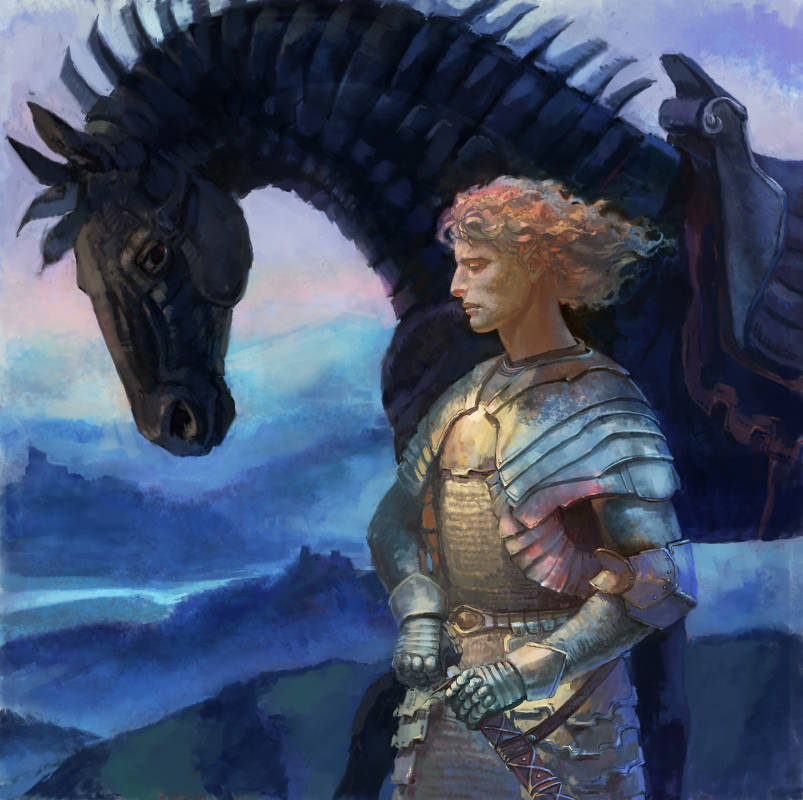 “Dilvish and Black,” fan art by Olga Sluchanko. Dilvish never had a cover painting this good in his damned life.
“Dilvish and Black,” fan art by Olga Sluchanko. Dilvish never had a cover painting this good in his damned life.
Dilvish, a.k.a. Dilvish the Damned, a.k.a. the Colonel of the East, first appeared in Fantastic under the guiding light of Cele Goldsmith, one of the great sf/f editors. After Goldsmith left the helm of Fantastic and Amazing, Zelazny continued to appear in those magazines, until he fell out with their new owner, Sol Cohen.
From that point Dilvish went into exile, the condition most natural for s&s heroes. He made appearances in a fanzine here, a small-press publication there. Zelazny’s hazy plan was to bring out a volume of Dilvish stories “to culminate in a possible novel, Nine Black Doves.” (Letter from Zelazny, 1965, quoted in the afterword to “Thelinde’s Song” in Power & Light.) When the Dilvish collection ultimately appeared from Del Rey in 1982, it was called Dilvish the Damned and it was paired with a booklength Dilvish adventure, The Changing Land.
A real golden age for Dilvish fans (which I had been since reading “The Bells of Shoredan” in a back-issue of Fantastic sometime in the mid-70s).
Or: maybe not.
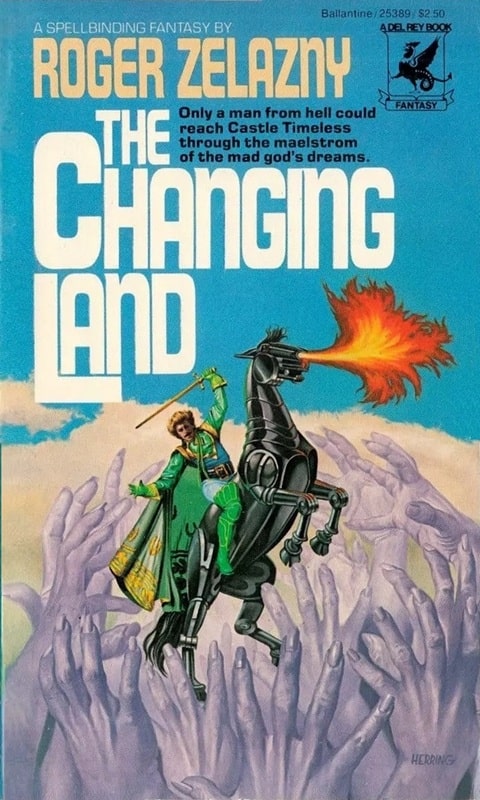
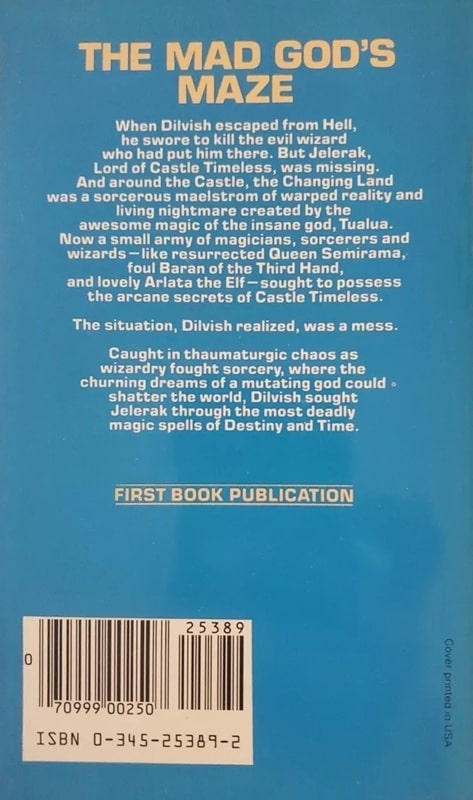
The Changing Land (Del Rey, April 1981). Cover by Michael Herring
I didn’t glom onto these books as soon as they were published; I’d been drifting away from buying books as my life became nomadic (and chaotic) in my early 20s. When I did finally get hold of the volumes I was, to say the least, underwhelmed. I wasn’t crazy about the covers, for one thing. Michael Herring is a talented artist, but I like his work better for sf; these covers are kind of Brothers-Hildebrandtish. (From some, that would be praise, but not from me. De gustibus non disputandum.)
I also didn’t like the titles: Nine Black Doves is weird and evocative; Dilvish the Damned and The Changing Land are blunt and dull declarations, like a can of peas with a generic black-and-white label PEAS.
But a book by Zelazny is a book by Zelazny, so I bought both paperbacks when I had a chance… and was not crazy about them.
“Even Homer nods,” I said to myself, and put them in a box somewhere.
When NESFA Press, that beacon of glory in sf/f publishing, produced its monumental series collecting all of Zelazny’s short fiction (Grubbs, Kovacs, and Crimmins ed.), of course I seized on the volumes as soon as I could, read them through, and loved them furiously.
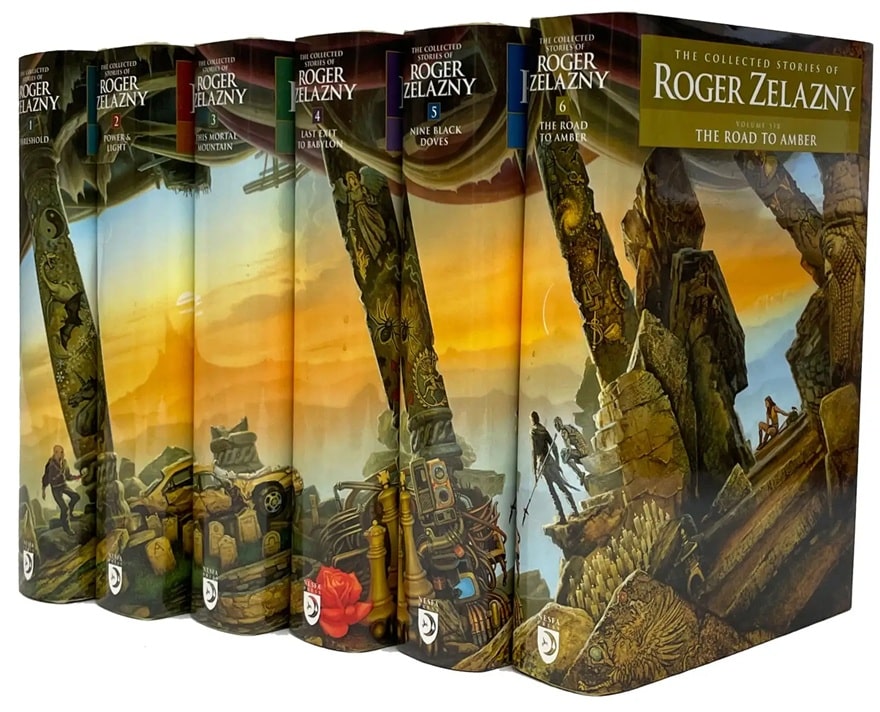 The Collected Stories of Roger Zelazny, all six volumes (NESFA Press, February – December, 2009). Covers by Michael Whelan
The Collected Stories of Roger Zelazny, all six volumes (NESFA Press, February – December, 2009). Covers by Michael Whelan
There were expected and unexpected pleasures in these volumes, but one of the surprises was how much I liked some of the Dilvish stories, tarnished in my fading memory by that 80s-era read. “I should reread the whole set of Dilvish stories together sometime,” I thought.
That was fifteen years ago, so maybe it’s time.
My executive summary, in case you don’t have the patience to read through these notes, is that the Dilvish stories contain some of Zelazny’s best writing, and some of his worst. My initial, uneasy thought was that the early stories were good and the later stories were bad, but that turned out to be too simplistic; one of the last Dilvish stories he wrote is maybe the single best thing in the two Dilvish books.
I reread the stories in the electronic version of the NESFA Collected Stories, which I recommend even more strongly than the original edition, because the editors have continued to revise and proofread the books. The design of the collections is to include the stories in the order they were composed, to the extent that can be ascertained, but they bend that rule when one story was written to provide backstory for another. (Which is exactly the right attitude toward rules. Rules should be governed by intelligence, not vice versa.)
Is Dilvish the Damned a novel or a collection of stories? I suppose I could waive the question, since I’m rereading the stories individually. But it’s a live question for work like this — a series of connected stories read as a whole. Lots of people call these things “fix-ups,” because that’s what Van Vogt called it when he smashed the bizarrely square pegs of his 1940s stories into the boring round holes of his 1950s paperback originals.
I don’t like the term because I hate Van Vogt’s fix-ups, and I also think that the best examples of this form (e.g. Leiber’s F&G volumes for Ace, or the various collections of C.L. Moore’s Jirel and Northwest Smith stories, or Howard Andrew Jones’ Hanuvar novels) don’t replicate Van Vogt’s mistakes: they respect the original stories, even when they create connective tissue to string the stories together. I call this kind of thing an episodic novel, and keep hoping that the term will catch on.
Whatever this thing is, here’s what I thought of it. (YMMV; de gustibus non disputandum; objects in mirror may be closer than they appear; etc.) This is already getting to be pretty long, so I’ll defer my thoughts about The Changing Land to another time (if ever).
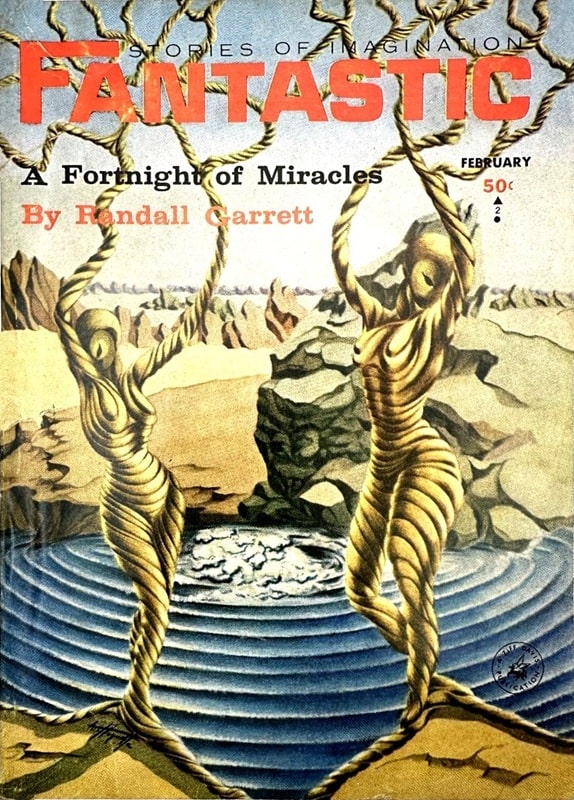 Fantastic Stories of Imagination, February 1965, containing the first Dilvish story, “Passage to Dilfar.” Cover by Heidi Coquette
1. “Passage to Dilfar” (1965, approx 2,000 words)
Fantastic Stories of Imagination, February 1965, containing the first Dilvish story, “Passage to Dilfar.” Cover by Heidi Coquette
1. “Passage to Dilfar” (1965, approx 2,000 words)
We meet Dilvish, already in progress, riding a horse made of steel named Black, “for whom it was said the Colonel of the East had bartered a part of his soul.” They are fleeing from a place called Portaroy, pursued by horseman sent by Lylish, Colonel of the West. (Dilvish himself is the aforesaid Colonel of the East.) Through hazards mundane and magical, they make their way to Dilfar, in the hopes that this city will withstand the onslaught of Lylish’s armies.
This is a very short story, approx 2,000 words, but it packs a strong, fantastical punch. It suggests a world far larger than anything it depicts. Zelazny claimed that he never intended to write a sequel, but Editor Goldsmith said it “begs for a series”, so Zelazny obliged. In fact, he started to plan a series of adventures, maybe to be capped with a novel called Nine Black Doves.
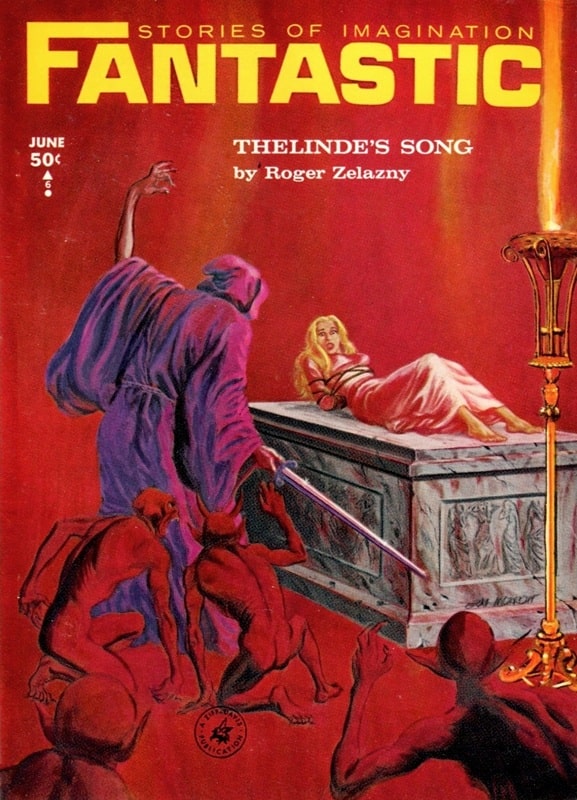 Fantastic Stories of Imagination, June 1965. Cover by Gray Morrow, illustrating “Thelinde’s Song.”
2. “Thelinde’s Song” (1965; approx 2,800 words)
Fantastic Stories of Imagination, June 1965. Cover by Gray Morrow, illustrating “Thelinde’s Song.”
2. “Thelinde’s Song” (1965; approx 2,800 words)
If you’re expecting an epic account of the defense of Dilfar against the slavering hordes of the Colonel of the West, that’s not where Zelazny is headed. There was such a defense, and it’s mentioned in passing here, including Dilvish’s final encounter with the warrior he met and bested (sort of) in the previous story.
But Dilvish himself doesn’t even appear as a character in this story, which is a conversation between the titular Thelinde and her witch-mother Mildin. Mildin explains the half-elven background of Dilvish, his victory in defending Portaroy in the old time, his magic green elf-boots, and his enmity with the evil and powerful wizard Jelerak.
Jelerak was using evil magic to evilly draw the youth out of a maiden; Dilvish tried to disrupt the ceremony; Jelerak changed Dilvish’s body to a statue and sent his soul to Hell. There Dilvish suffered for centuries, but now he’s escaped with a demonic horse named Black and Jelerak, with all his power, now has something to worry about.
This story isn’t much longer than “Passage to Dilfar.” Where “Passage” was all action, this is all exposition, and at times it seems like Zelazny has a list of things he wants his mouthpiece to talk about (e.g. Dilvish’s green elf-boots, magical equipment which you would think would affect the stories a lot, but usually do not). Still, this quasi-story is vivid and impactful and sketches in details about Dilvish and his world that make them loom even larger in the imagination.
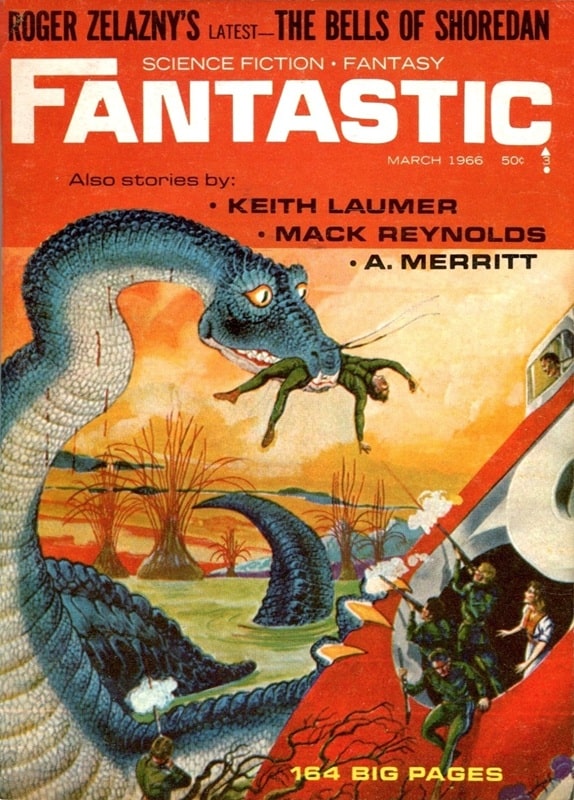 Fantastic, March 1966, containing “The Bells of Shoredan.” Cover by Frank R. Paul
3. “The Bells of Shoredan” (1966; approx 6,200 words)
Fantastic, March 1966, containing “The Bells of Shoredan.” Cover by Frank R. Paul
3. “The Bells of Shoredan” (1966; approx 6,200 words)
In this much longer story, Dilvish goes to the ruined city of Shoredan to ring its bells and summon its legions of the dead to fight against the Colonel of the West. On the way he must confront the ghost of his Elvish forebear Selar and the demon who tortured Dilvish in Hell, Cal-den. On the way he acquires the invisible blade of Selar.
If you like this kind of thing, you will like this story a lot. A sword-and-sorcery classic. If you read only one Dilvish story, it should be this one.
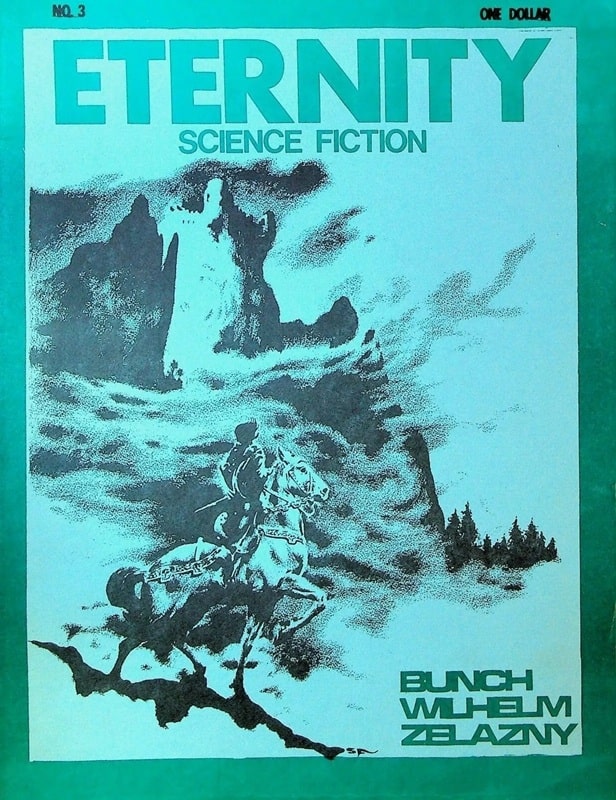 Eternity Science Fiction #3, 1974, containing “A Knight for Merytha.” Cover by Stephen Fabian
4. “A Knight for Merytha” (1967; approx 3,000 words)
Eternity Science Fiction #3, 1974, containing “A Knight for Merytha.” Cover by Stephen Fabian
4. “A Knight for Merytha” (1967; approx 3,000 words)
Again, where an epic fantasist would zig (i.e. follow up the previous story by describing the battle of the dead against Lylish), Zelazny zags. We catch up with Dilvish for a solo adventure as he travels alone with his steel horse and demonic sidekick Black.
And, if you were expecting more progress on the Jelerak plotline, that doesn’t happen either. Zelazny later described Dilvish as a man obsessed with revenge, but that isn’t clear in the actual stories. Jelerak isn’t mentioned at all in the first Dilvish story, or in this one, where he is scouting ahead of the “doomed army” he summoned to defeat Lylish.
Like a knight sans peur et sans reproche, Dilvish responds to the cry of a woman in distress (even though his wily steed warns him against it). If you think you know where this story is going, you probably do, but it’s a solid fantasy adventure involving a vampire. Sword-and-sorcery meets Hammer Horror. Cast Ingrid Pitt as Merytha and you’ve got it.
One particular detail that struck me about this story — more a worldmaking question than an issue with the story itself — is the use of the invisible sword of Selar (which Zelazny acquired in “Shoredan”). It’s hard to see (wokka-wokka-wokka) how such a sword would actually be useful. No doubt there’s a surprise factor when you approach your foe armed, but apparently empty handed. But how do you fight with it? You, as much as your opponent, need to know where your point is so you can stab him with it. There’s a great series of movies about a blind swordsman Zatoichi, but on film that stuff works because your eye sees it and the mind accepts it.
It wasn’t clear to me what skills Dilvish had or developed to make use of the invisible blade. Zelazny was a fencer and pursued a number of different martial arts and he may have had ideas about it, but the invisible blade disappears after this story, along with Lylish and the defense of Dilfar.
“A Knight for Merytha” originally appeared in a fanzine and was the last of the Dilvish stories for a while. Zelazny wasn’t sending his work to Fantastic or Amazing anymore, due to his quarrel with their new publisher, and when he got the sword-and-sorcery itch he would write about other characters — Sam the Buddha and his pseudo-divine frenemies, or Corwin of Amber and his quasi-divine familenemies.
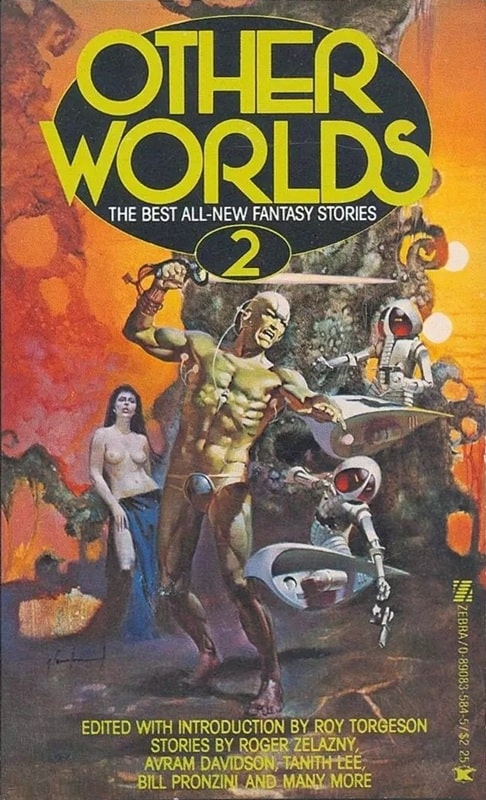

Other Worlds 2, edited by Roy Torgeson, containing
“The Places of Aache” (Zebra, January 1980). Cover by Jordi Penalva
We again find Dilvish wandering through strange lands alone (except for his faithful Black). He runs into a would-be robber who’s disconcerted by Dilvish’s militant response. The robber thinks he has protection from a local goddess, who authorizes his career of crime, but that doesn’t save him from Dilvish’s (non-invisible) sword.
Dilvish goes on to confront the sinister priest of the goddess, and the goddess herself. She’s a monstrous, many-limbed creature, and at this point you might expect an epic battle. What actually happens is that Aache (the monster-goddess) and Dilvish talk, and he figures out a solution for her particular set of problems. But there’s a menace lurking that neither of them expect, and the story ends on a tragic note.
This is a solid sword-and-sorcery adventure where the hero displays intelligence and compassion as well as ruthlessness and fighting skill. (The conversation between Dilvish and Rogis the robber is classic, Hammett-level tough-guy dialogue.)
There’s no mention of Jelerak here; there’s no mention of Lylish and the military conflict over Portaroy, Dilfar, etc.
6. “A City Divided” (1982)Originally published in Dilvish, the Damned.
We again find Dilvish wandering through strange lands alone (except for his faithful Black). (Yes I did just cut-and-paste that from the section above.) While travelling in the North Country, Dilvish falls into a city-sized trap, where a magical game is being played between two sorcerers. Dilvish’s fighting ability and Black’s infernal strength can’t get them out of this one, so Dilvish turns to magic — one of the twelve Awful Sayings that he learned in Hell.
There’s some good stuff here: conversations between Dilvish and Black, the depth of infernal lore suggested by a few strategic details, the conversation between Dilvish and the sorcerer Strodd at the end of the story.
But there’s also a lot of narrative busywork as Dilvish and Black try to negotiate the maze inside the city. Mazes are weird and perplexing when you’re in them, and that kind of experience films well (I’m thinking of a couple of very different scenes in The Stand and in Sleuth), but I don’t think it works well in fiction. Anyway, it didn’t work for me in this fiction.
The conflict with Lylish is mentioned (as completed in the past), and Jelerak is discussed at the end, including the place Dilvish expects to find him, the Tower of Ice. So there’s at least some attempt to fit this story into the over-arching plotline of the series.

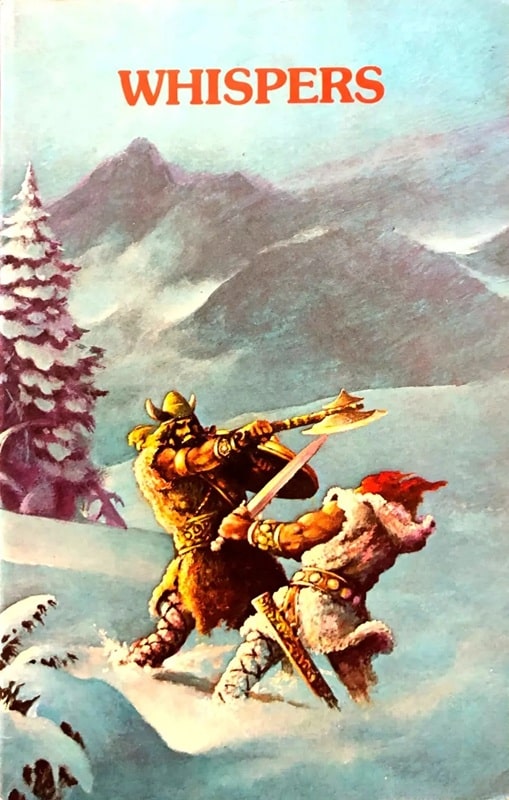
Whispers 2, October 1979, edited by Stuart David Schiff, containing “The White Beast.” Cover by Steve Fabian
We again find Dilvish wandering through strange lands alone (except for his faithful Black). My cut-and-paste notwithstanding, I don’t object to this generic type of beginning. Zelazny varies the descriptions to keep the thing interesting, and a sword-and-sorcery hero is usually a loner or at least an outsider. In this story, for instance, Dilvish’s name doesn’t appear until three-quarters of the way through this very short (approx, 1,200 words) story. He’s just described externally.
Now Dilvish is deep in the north, in a landscape of snow and ice, and he is being pursued through the icy wasteland by a white werebeast. Dilvish is not the guy to back away from a fight, but instead of killing the monster he offers to split his food with it. They engage in conversation and discover they have a common enemy.
This is only an episode, leading to the longest Dilvish story (except for the novel, The Changing Land), but it’s vivid and haunting.
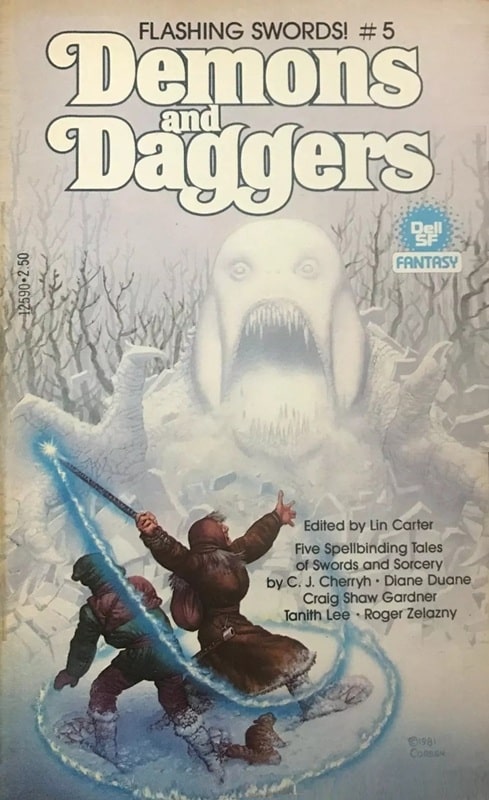
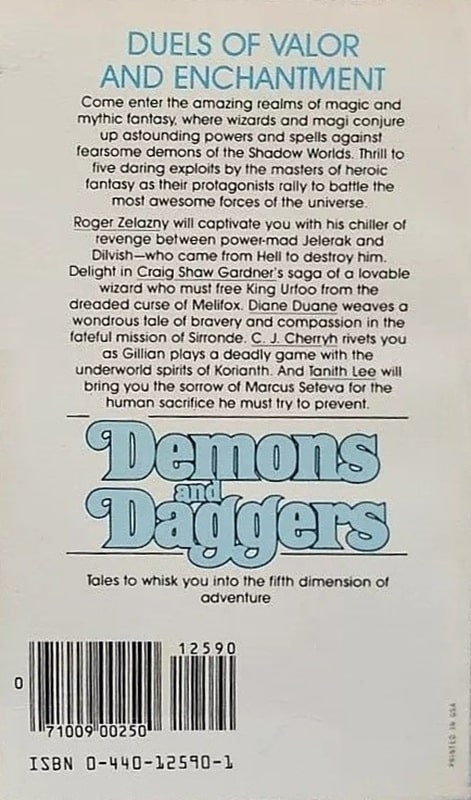
Flashing Swords! #5: Demons and Dagger, edited by Lin Carter,
containing “Tower of Ice” (Dell, December 1981). Cover by Richard Corben
We again find Dilvish wandering through strange lands alone (except for his faithful Black). But this is no mere random episode: Dilvish has finally reached one of Jelerak’s strongholds and hopes that he can have his long-sought-for confrontation with this Evil Wizard Who Is Evil… if he can just get into the damned place.
This is the longest of the Dilvish stories (except for the novel, The Changing Land). It was one that Zelazny had long planned on writing. And it is, in my view, the worst of the Dilvish stories (except for the novel, The Changing Land).
What went wrong? (If you love this story, you may be screaming “NOTHING!” so hard at your device that the screen cracks. But don’t do that. De gustibus non disputandum. And you can always write your own review.)
For one thing, this story was a rush job, and it shows.
The stage was finally set [for the novella ‘Tower of Ice’]. But I had no intention of carrying things further at that point. I was busy writing the novel Roadmarks and wanted to get on with it. A week after I’d sent off ‘The White Beast,’ though, I received a request from Lin Carter for a 20,000 word Dilvish story for Flashing Swords #5. It seemed like the Finger of Fate. I allowed myself a week and wrote ‘Tower of Ice.’
— Zelazny in Alternities 6 (Summer 1981), quoted in the NESFA collection Last Exit to Babylon (Grubbs, Kovacs, and Crimmins ed.)
There’s a lot of stuff in here: a brother and sister with a sorcerous connection, a wizard with multiple personalities struggling to control his power and himself, a sorcerer’s apprentice readying himself to confront his evil master in a magical duel to the death, a magic mirror prophesying a doom that grows ever closer, a captive demon, a demented monster in love with a demented witch who commands an army of demented rats. Etc! I say yay to all this. More is more!
Some of these people are the same person, but (significantly) none of them is Dilvish. This is not really his story, although we spend a lot of it following him around. There’s a lot of narrative busywork getting him into the Tower of Ice, and then a lot more to get him out, without fighting Jelerak, even though that nemesis shows up (in non-physical form). Dilvish departs with Reena, the sister of Ridley, Jelerak’s rebellious apprentice, and it’s Ridley who fights Jelerak. Jelerak seems to kill him and escape at the end of the story.
The upshot is that Dilvish is back on the road again, now with a female companion. The whole novella is just a narrative cul-de-sac, where Dilvish goes one way only to come back the way he came. No progress on Dilvish’s quest is made at all, and it’s not a satisfying episode (unlike many that preceded it and some that follow) because Dilvish doesn’t take any significant action that affects the story.
You never know what might have happened, but if Zelazny had taken more time writing this story, he might have made its diverse elements cohere into something more worth reading.
9. “Devil and the Dancer” (1982, approx 15,000 words)Originally published in Dilvish, the Damned.
We again find Dilvish… Wait a second. No we don’t.
This novelette opens with a witch-priestess named Oele dancing a fiery ritual before the “empty stone-faced altar” of a dying god. This god (whose name she doesn’t know, so she calls him “Devil”) repays her with magical and material benefits. She is his last worshipper, and without her he’ll die (or undergo a transition that is like death to a god). She gained her power from the god by sacrificing her lover to him; now he needs a new sacrifice to maintain his strength. She goes in search for one and will find… Dilvish, the only man who still remembers the name of the dying god.
This is one of the best Dilvish stories. Everything that goes wrong in “Tower of Ice” goes right here. The novelette is stuffed with interesting, distinctive characters: Oele the witch-priestess, her devil-god who needs and hates her, an old man who shall be nameless at this time, an adventurous and temptable ship-captain named Reynar, witchy Reena (who travels with Dilvish but who knows he isn’t for her), and Dilvish himself, who takes crucial action to resolve the Gordian knot of conflicting quests that cross the empty altar of the dying god.
“Devil and the Dancer” is 15,000 words long, with not one wasted. The final brief paragraph is a dagger that stabs deep; the weight of the whole story is behind it.
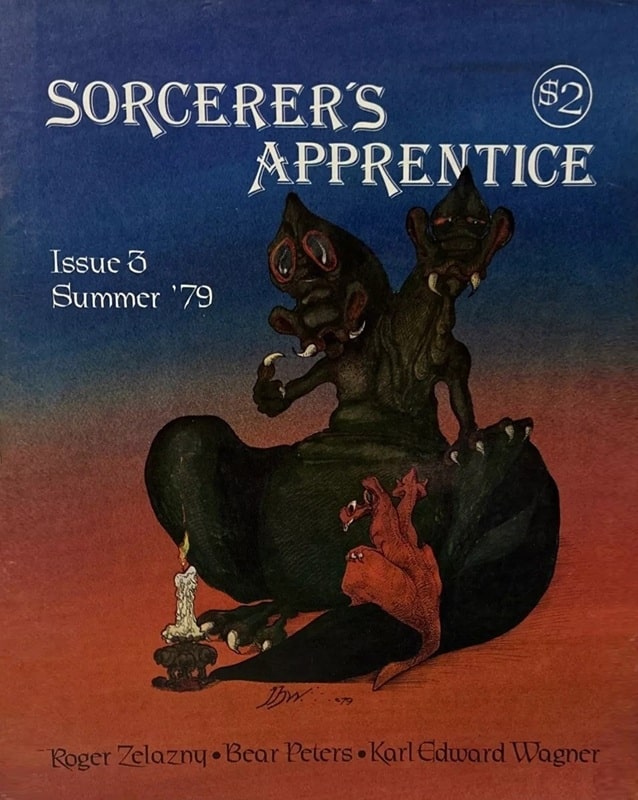 Sorcerer’s Apprentice, Summer 1979, edited by Ken St. Andre, containing “Garden of Blood.” Cover by Joan Hanke-Woods
10. “Garden of Blood” (1979)
Sorcerer’s Apprentice, Summer 1979, edited by Ken St. Andre, containing “Garden of Blood.” Cover by Joan Hanke-Woods
10. “Garden of Blood” (1979)
We again find Dilvish wandering through strange lands alone (except for his faithful Black). (According to the first paragraph, he’s working as a scout for a caravan, but we never see the caravan and it doesn’t affect the course of the story much, if at all.)
The lands are strange to us, but not to him. He’s been over this ground before, before he was trapped for 200 years in hell. He finds himself in the ruins of a town he once knew, named Trelgi. He and Black pass onward to a fair field full of bright flowers, where the town’s ancient stone altar still stands.
Through some combination of magic and narcotics from the flowers (flashback to the poppy scene in The Wizard of Oz), Black is paralyzed and Dilvish finds himself trapped in a dream or vision where he and Black (in human form) fight against the robbers who sacked Trelgi and slew its inhabitants.
A solid adventure-fantasy, well worth reading.
11. “Dilvish the Damned” (1982)Originally published in Dilvish, the Damned.
The last two Dilvish stories (apart from the novel) have something in common that distinguishes them from the others. We find Dilvish working for a living. He may be a somewhat sorcerous person who rides a demonic metal steed, but he apparently can’t pull gold coins out of Black’s ears, or other orifices. I like this, as supplying the grit that s&s needs (Joe McCullough’s great definition of sword-and-sorcery is “Fantasy with dirt.”) But it does put the end of this series on a different, more mundane level than its dreamlike, allusive beginnings.
After getting paid and buying supplies, he sets off for a castle called Timeless:
The blind poet and seer, Olgric, had told him that he would find there the thing that he sought.
But before Dilvish gets there, a guy on the road tries to rob him. The robber is pretty inept, and Dilvish in the end is inclined to let him go, but he tries to impale himself on Dilvish’s sword. It turns out that he’s been trying to get Dilvish to kill him. Dilvish is intrigued and, in spite of Black’s warnings, he stops to get the thief’s story.
The thief is named Fly and he is the walking definition of the phrase “mealy mouthed.” (He keeps saying things like “Well, yes and no.”) Dilvish eventually gets his story: he stole a magic belt from a god’s temple; now the adherents of the god are after him, as well as the adherents of a rival god who want the belt for their own purposes.
There’s some wiliness and chasing and fighting and a curse or two but, in the end, Dilvish returns the belt to the god from whom it was stolen, and he and his demonic steed get the hell out of there.
After the story proper, there’s a short coda. The next day, Dilvish is confronted by a young woman who begs for his help. Black warns him not to be taken in, and we’ve actually seen Dilvish tricked this way before (“A Knight for Merytha”).
But Dilvish can’t bring himself to deny a plea for help. ” ‘Damned if you do, damned if you don’t,’ he said, dismounting.” Which is at least kind of an amusing punchline to the series, if not laugh-out-loud funny.
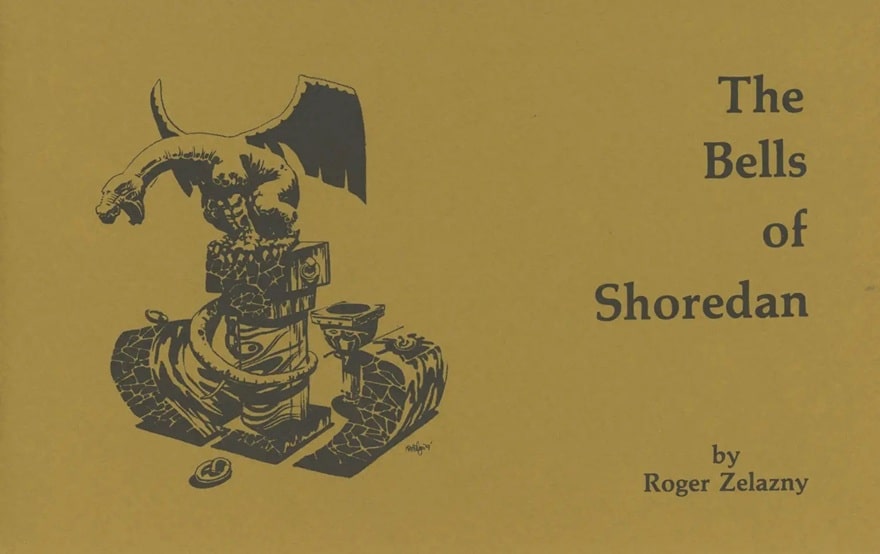 The Bells of Shoredan (Underwood Miller, May 1979). Cover by Matt Gouig
Overview
The Bells of Shoredan (Underwood Miller, May 1979). Cover by Matt Gouig
Overview
The parts of the Dilvish series are greater than the whole. Some stories, I would argue, are essential reading for the heroic fantasy enthusiast (e.g. “Passage to Dilfar”, “The Bells of Shoredan”, “Devil and the Dancer”). Most of the rest are well worth reading (e.g. “The Places of Aache”, or “Garden of Blood”). The weakest and longest story in this series (setting apart The Changing Land for another time) is “Tower of Ice”, and even it has some interesting stuff in it.
But it has nothing that connects it all together. It’s a set of fragments. Zelazny would have it that Dilvish is a man obsessed. He calls him “a humorless monomaniac.” (This from a letter to Carl Yoke, quoted in the afterword to the last Dilvish short story in the NESFA collection Nine Black Doves.) But Dilvish has at least two sets of concerns in the stories: defending Dilfar and other cities of “the East” from Lylish, the Colonel of the West, and also getting revenge on Jelerak, neither of which seem to me to be crazy. And most of the stories don’t involve either one of these goals, or mention them only in passing, undermining any picture of Dilvish as obsessive.
Zelazny knows his character better than anyone else does, obviously, but my point is that he doesn’t create the portrait of a monomaniac in the Dilvish stories that he actually wrote and published. There isn’t that much coherence in them. When Dilvish raises a ghost legion to fight for him in Shoredan, the actual fight he raises them for occurs offstage and is mentioned only in passing. Lylish and Jelerak are supposed to be these big menaces, but Lylish never appears onstage, and Jelerak only occasionally and somewhat unimpressively. Zelazny is careful to introduce us to a sorcerer named Strodd in “A City Divided” and make him indebted to Dilvish… but he’s only mentioned once in passing, later on, and he never appears in a Dilvish story again.
The good stuff in the stories is mostly the incidental stuff along the way. There is no overarching plotline that connects them, any more than there is for Leiber’s stories of Fafhrd and the Gray Mouser or REH’s Conan stories.
And that’s a virtue, not a vice. Zelazny’s great gift as a writer was for brilliant improvisation. These stories would be better if they were presented as a series of fragments from a heroic life, without any pretense of telling a continuous story.
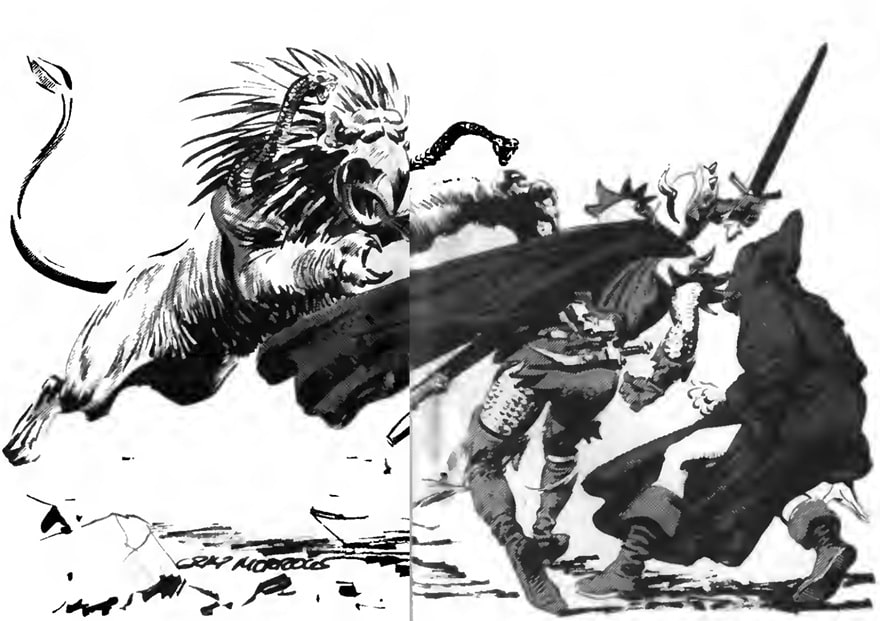 Interior art for “The Bells of Shoredan” by Gray Morrow. From Fantastic Stories, March 1966
Interior art for “The Bells of Shoredan” by Gray Morrow. From Fantastic Stories, March 1966
That was Howard’s idea for the Conan series:
“The average adventurer, telling tales of a wild life at random, seldom follows any ordered plan, but narrates episodes widely separated by space and years as they occur to him.” (From a letter REH wrote in 1936 to P.S. Miller, included in the Lancer/Ace Conan, p.17.)
I’m not saying every s&s writer has to imitate REH forever, but this approach would work better with the Dilvish stories than the pseudo-biography that Zelazny tries to force them into.
The reader who has read this far without dying of boredom deserves some kind of ringing peroration to send them rushing out into the street in search of trouble and fantastic adventure. Unfortunately I don’t have one.
I do have kind of a technical writing observation that, if nothing else, will help you to drift off to sleep in the friendly light from whatever device you’re reading this on.
In most of the Dilvish stories, we get almost nothing of Dilvish’s inner life. We have to deduce what he’s thinking and feeling from his words and actions — the same way we do with the people around us. This is unlike a lot of modern fiction, where we typically get the inner monologue of the viewpoint character. In lots of ways, Dilvish is not our viewpoint character; he is a character we are viewing.
That appeals to me because it’s more like ancient and medieval literature, and it gives him a degree of mystery. The later stories in the series where we get more of Dilvish’s feelings are part of that descent into mundanity, like the mentions of him working for a living. I don’t think that’s bad; it’s just interesting how Zelazny’s approach to the character changed over the nearly-two-decades that he wrote about him.
Now go ye forth into the mysterious vale of night and smite those who must be smitten, even as your heart doth compel ye. (Unless that seems inadvisable for ethical, legal, or practical reasons. Offer void where prohibited.)
Our previous coverage of Dilvish at Black Gate includes:
Dilvish, the Damned by Fletcher Vredenburgh (September 12, 2017)
This article originally appeared at James Enge’s excellent Engeblog on January 23, 2025.
There, Wolves: Part III
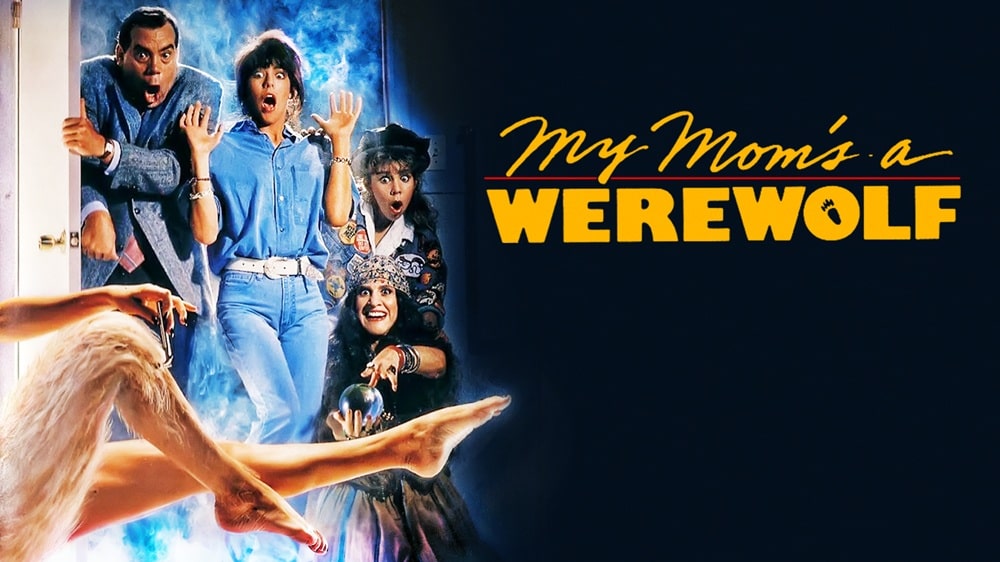 My Mom’s a Werewolf (Crown International Pictures, May 12, 1989)
My Mom’s a Werewolf (Crown International Pictures, May 12, 1989)
A 20 film marathon of werewolf movies I’ve never seen before.
As usual, the films must be free to stream.
I’ve got a bad feeling about this.
My Mom’s a Werewolf (1989) YouTubeMan or beast? Gradual, hairy transformation into rubbish suits.
Howlin’ good time? The 80s are arguably the greatest decade for horror and, perhaps, the much maligned sub-genre of horror comedy, but this one squeaks in at the end hoping to ride some Teen-Wolf coat tails, and it doesn’t quite succeed. The intention is there, everyone gives it their all to a cartoonish level, and John Saxon is awesome, but for me the jokes didn’t always land, and it felt horribly dated.
The film has a similar premise to the OG Fright Night (teen recruits monster nerd friend to combat monster and save family), but it was all a bit too cutesy for my tastes and, despite the promise of a great werewolf at the end, the actual makeups were a bit of a let down. Fun to see Ruth Buzzi again though, looking younger than she did in the 60s.
5/10
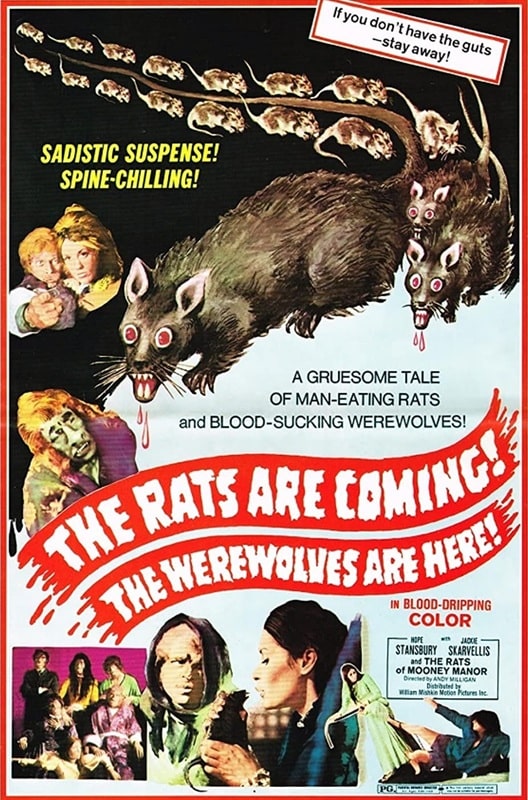
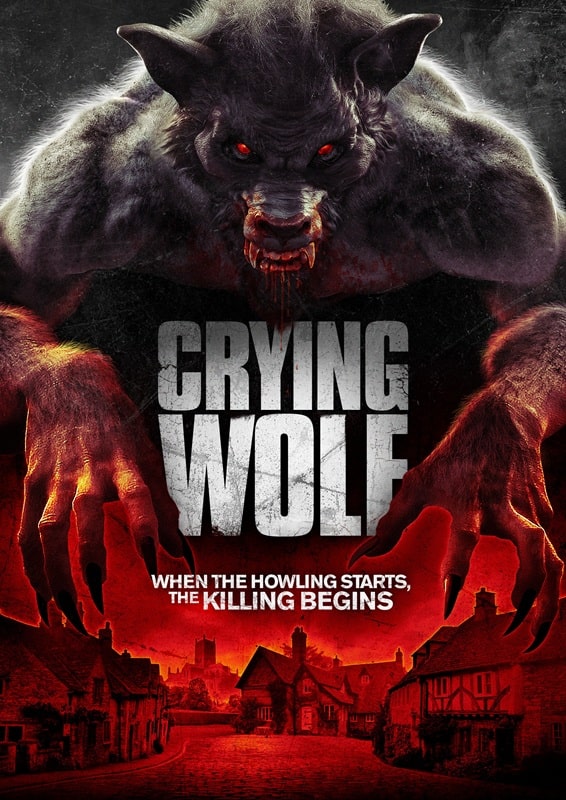
The Rats Are Coming! The Werewolves Are Here! (William Mishkin Motion
Pictures, May 1972) and Crying Wolf (Uncork’d Entertainment, 2015)
Man or beast? Brownface + hairy eyebrow makeups.
Howlin’ good time? This is a film from the notably sleazy mind of Andy Milligan, who once enjoyed stuffing his grindhouse efforts full of sadism and salaciousness. This film, however, is his tamest by far, with nary a whiff of sex or violence (although he does include a ghastly bit of sadistic treatment towards a live mouse, which is unpleasant).
The best thing about this movie is the title, but even the rats are merely a ten-minute distraction, presumably an after-thought, during this dull exercise in miserable family members sitting around moaning about being werewolves. The actual beasts appear at the end, when everyone seemingly turns into one and set upon each other for no good reason. Pretty awful.
3/10
Crying Wolf (2015) TubiMan or beast? CG/gorilla suit hybrids.
Howlin’ good time? Full transparency, I put this one on because Caroline Munro headlines it, but when she disappears after 5 mins, I should have done the same.
This is such an odd film, but not in the charmingly odd sense. Allegedly a comedy, it’s as cutting edge as a Benny Hill sketch but with none of the subtlety, complete with head turn ‘whooshes’ and slide whistles. The thin-as-tissue plot is padded out with flashbacks, and flashbacks within flashbacks, none of which bring anything to the story.
There a couple of fun gore effects, but it’s hampered by some lousy CG and awful werewolf costumes, and the whole affair has been re-dubbed using some lacklustre ADR and one awful American accent. The whole hot mess is narrated by a detective in a pub, and it comes off as a prolonged episode of Garth Merenghi’s Dark Place, but with worse production quality. Terrible.
3/10
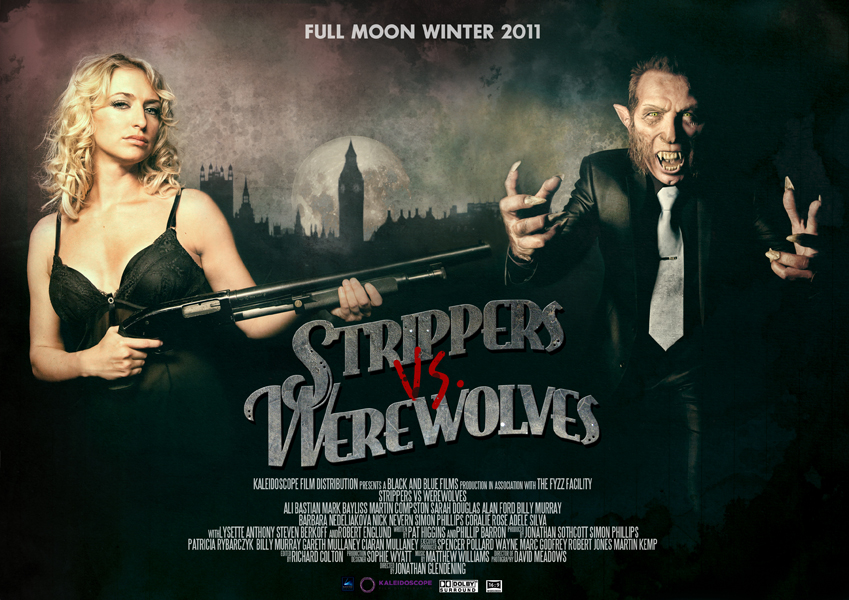 Strippers vs Werewolves (Well Go, April 27, 2012)
Strippers vs Werewolves (2012) Prime
Strippers vs Werewolves (Well Go, April 27, 2012)
Strippers vs Werewolves (2012) Prime
Man or beast? Hairy, humanoid, beast-faced bad boys.
Howlin’ good time? I went into this one expecting the usual crap (having seen Zombies vs Strippers in a moment of weakness a couple of years ago), but was a little surprised by how much I liked it. Don’t get me wrong, it’s still rubbish, released the same year as the superior (but still rubbish) Cockneys vs Zombies, but clearly everyone was having a splendid time, and there were a couple of gags that managed to get a laugh out of me.
It’s a UK production through and through, taking place in Basildon (and finishing in Dagenham!) and full of your stereotypical Essex-types, but I wasn’t ready for the cameos from folks in need of new patios, including Steven Berkoff, Robert England, Martin Kemp, Lysette Anthony and Sarah Douglas (who was the best part of the film). It’s rude, slightly violent and full of knockers, which is to be expected, daft as a brush, but still more fun than many of the films I’ve watched during this project and I didn’t hate the werewolf designs.
Recommended for people who like Alan ‘Brick Top’ Ford and bosoms.
6/10
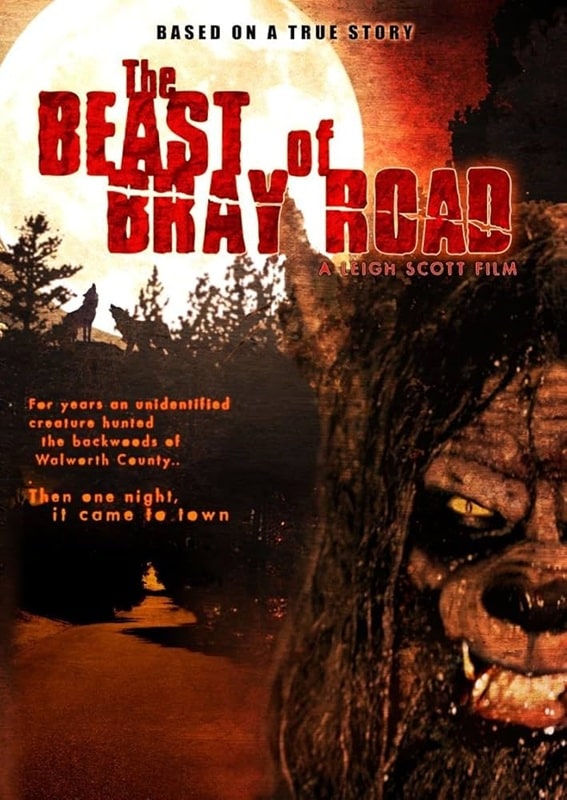 The Beast of Bray Road (The Asylum, September 1, 2005)
The Beast of Bray Road (2005) YouTube
The Beast of Bray Road (The Asylum, September 1, 2005)
The Beast of Bray Road (2005) YouTube
Man or beast? Hairy, humanoid, naughty thing.
Howlin’ good time? It’s an Asylum flick, but don’t let that put you off. Granted, it’s the usual fare; two-dimensional charac… sorry… cannon fodder going through the motions, hitting their marks and spouting uninspiring dialogue. However, a great portion of the budget went on practical effects, including more loops of guts than a back-alley sausage shop. The gore was over the top and fun, the beast however was a bit of a laugh. In fact, this poster doesn’t do the film any favours, and I can’t believe they didn’t hire an artist to paint a kick-ass werewolf for it.
As it is, this one just reminded me of Zeb from Star Wars: Rebels (if you know, you know), and I couldn’t take it seriously. Ultimately though, it’s a better-than-most Asylum effort, and I was entertained, so… congrats?
6/10
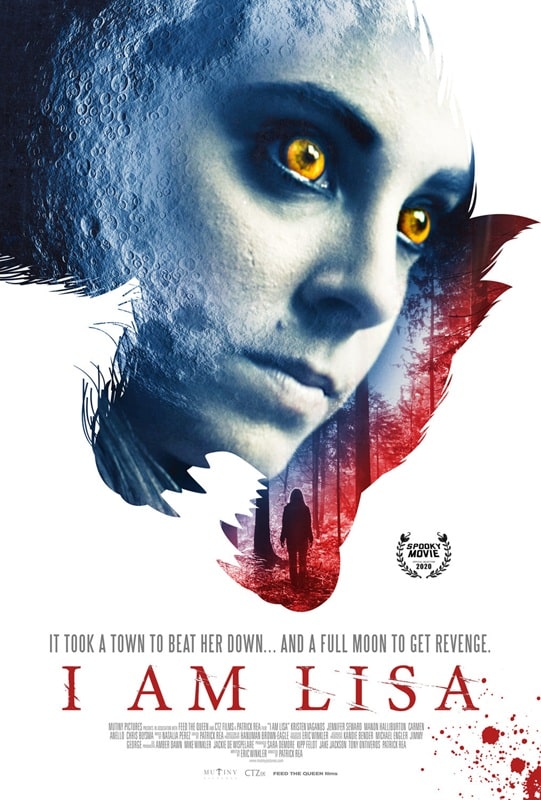
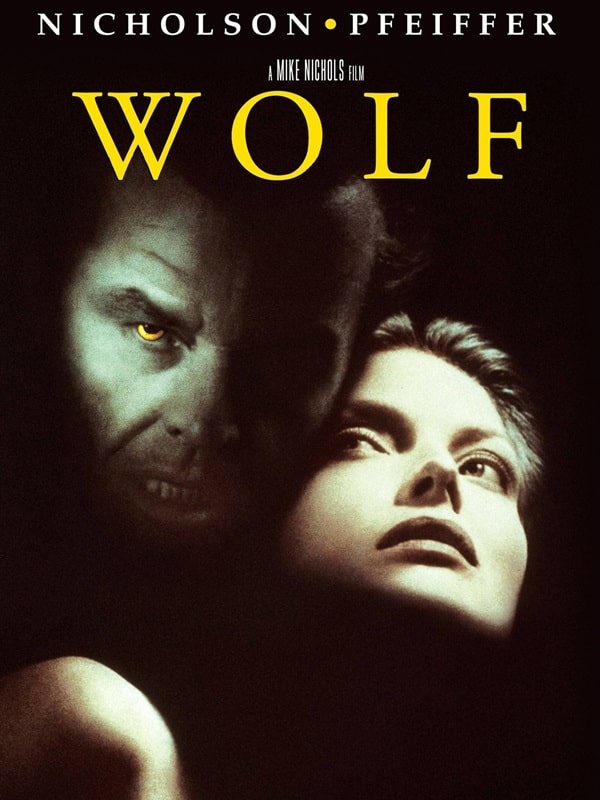
I Am Lisa (Mutiny Pictures, July 2, 2020)
and Wolf (Columbia Pictures, June 17, 1994)
Man or beast? Subtle lady beast.
Howlin’ good time? I’m glad I saved this one until close to the end of my werewolf watch-a-thon, because I was quite impressed with this indie film, shot on a low budget but spending the money wisely. It’s a tale of abuse and revenge, with strong female leads, well-written queer undertones and some lovely cinematography. I thought the director Patrick Rea handled the story really well and the score had a nice throwback vibe to it. In fact, the whole shebang put me in mind of I Spit on your Grave, with more teeth.
My only gripes lay with the sound design and the fight choreography, neither of which packed enough punch and let down the climax, but overall it’s a solid watch and I’m going to go ahead and recommend it.
8/10
Wolf (1994) PrimeMan or beast? Nicholson and Spader being hairy.
Howlin’ good time? Saved a ‘proper’ film for last, because it would be nice to go out with a bit of quality, and I hadn’t seen this before. However, I was wholly unprepared for how ludicrous and dull it actually is.
At the risk of invoking the wrath of those of you who fondly* remember this as being great, let me just express my surprise over so much before and behind the camera talent coming up with this wereturkey. It features amazing actors, Mike (The Graduate) Nichols directing, FX from Rick (American Werewolf in London) Baker and a score by Ennio (Ennio freakin’ Morricone) Morricone, and yet it is still as dumb as a bag of wolf nards. The lycanthropic plot is reduced to a subplot as the main focus is about a guy getting his job back, and its direction is a bit aimless (unlike Jack’s pee).
Is it a satire? Not funny enough. Is it horror? It’s got less teeth than grandma shark. Gah — maybe at this point, now finished with the werewolf movies, I’m jaded, cynical and ready to move on — but I really was expecting better.
6/10
*incorrectly
Previous Murkey Movie surveys from Neil Baker include:
There, Wolves: Part I
There, Wolves: Part II
What a Croc
Prehistrionics
Jumping the Shark
Alien Overlords
Biggus Footus
I Like Big Bugs and I Cannot Lie
The Weird, Weird West
Warrior Women Watch-a-thon
Neil Baker’s last article for us was There, Wolves: Part II. Neil spends his days watching dodgy movies, most of them terrible, in the hope that you might be inspired to watch them too. He is often asked why he doesn’t watch ‘proper’ films, and he honestly doesn’t have a good answer. He is an author, illustrator, outdoor educator and owner of April Moon Books (AprilMoonBooks.com).
Love is in the Air | 9 Steamy Romance Novels to Devour
Okay, romance novel lovers, cuddle up with your warm blanket in your favorite reading spot.…
The post Love is in the Air | 9 Steamy Romance Novels to Devour appeared first on LitStack.

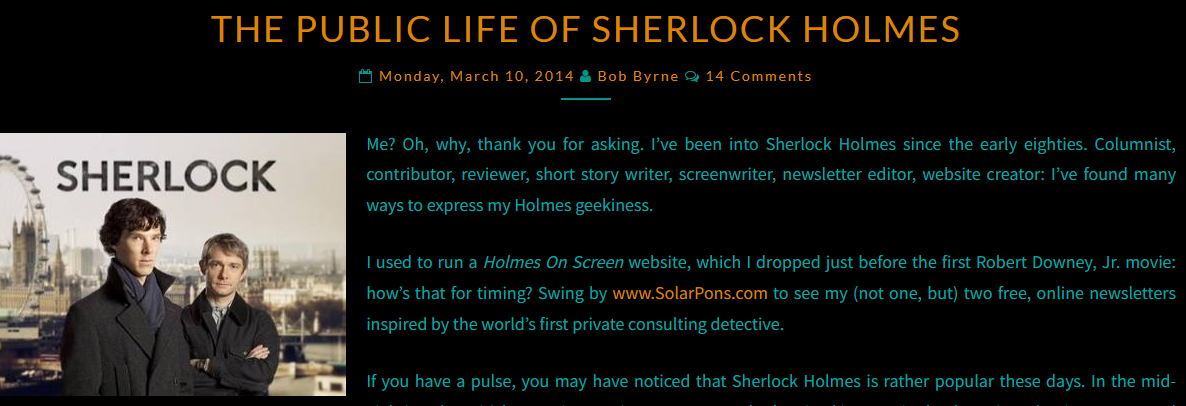
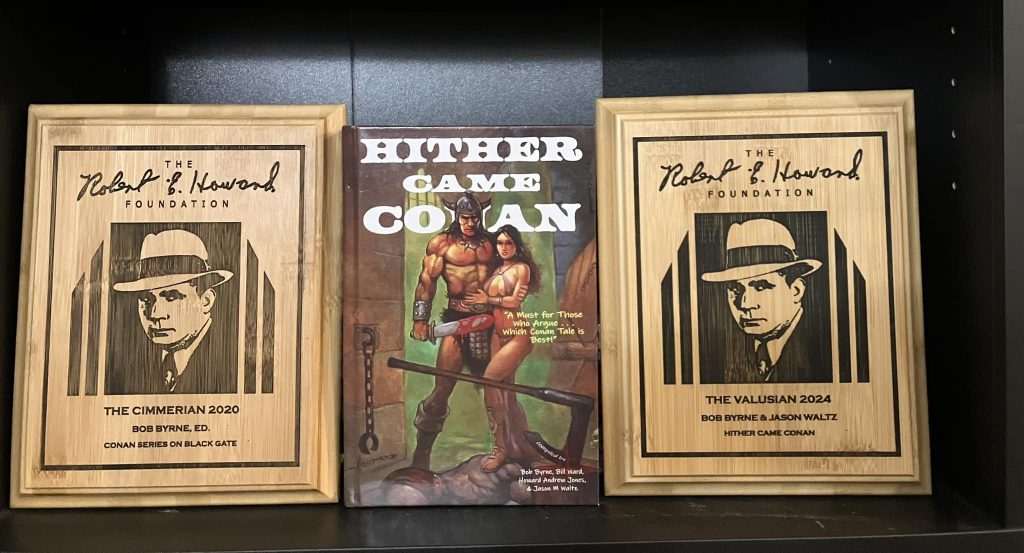
Recent comments